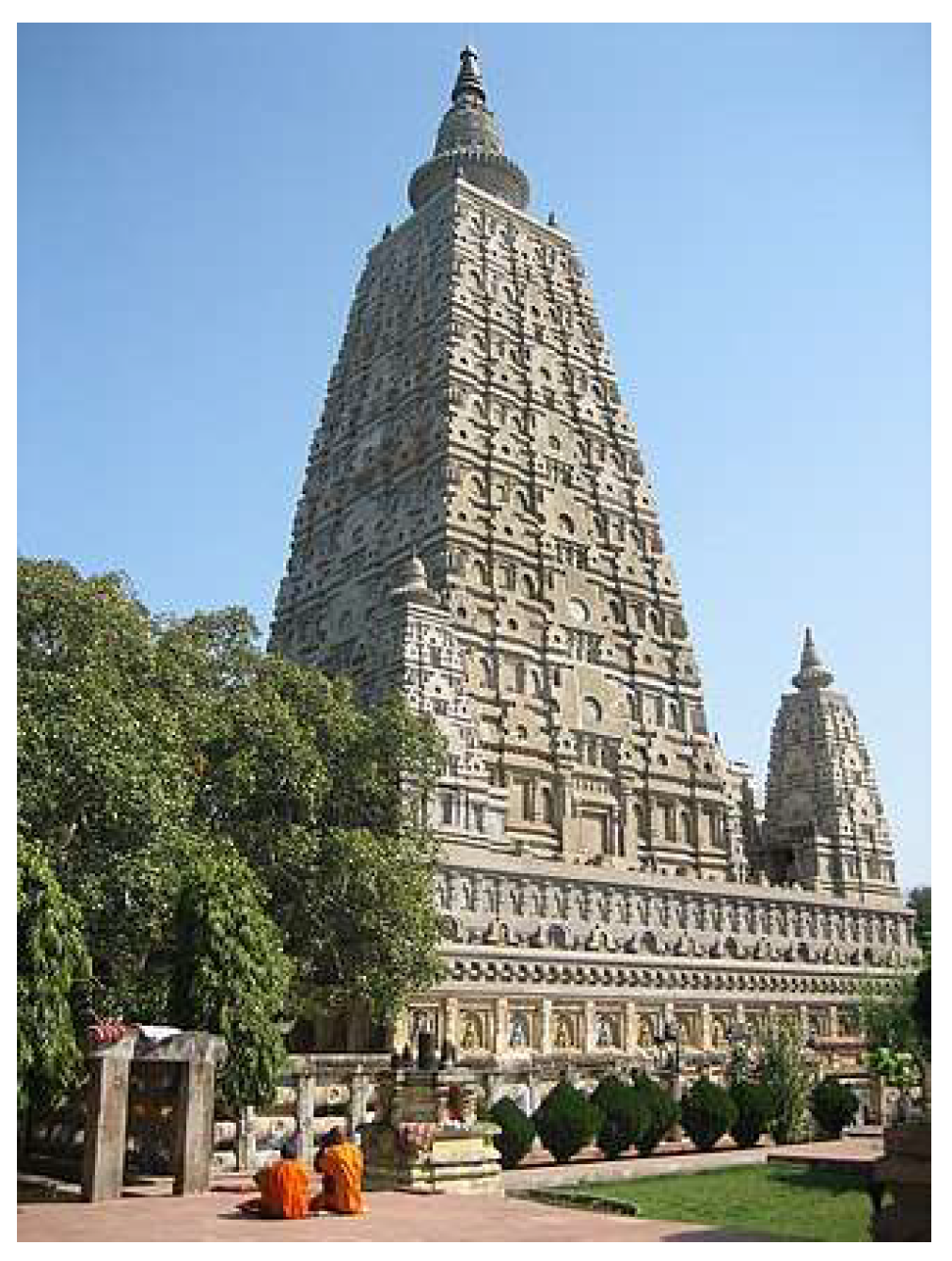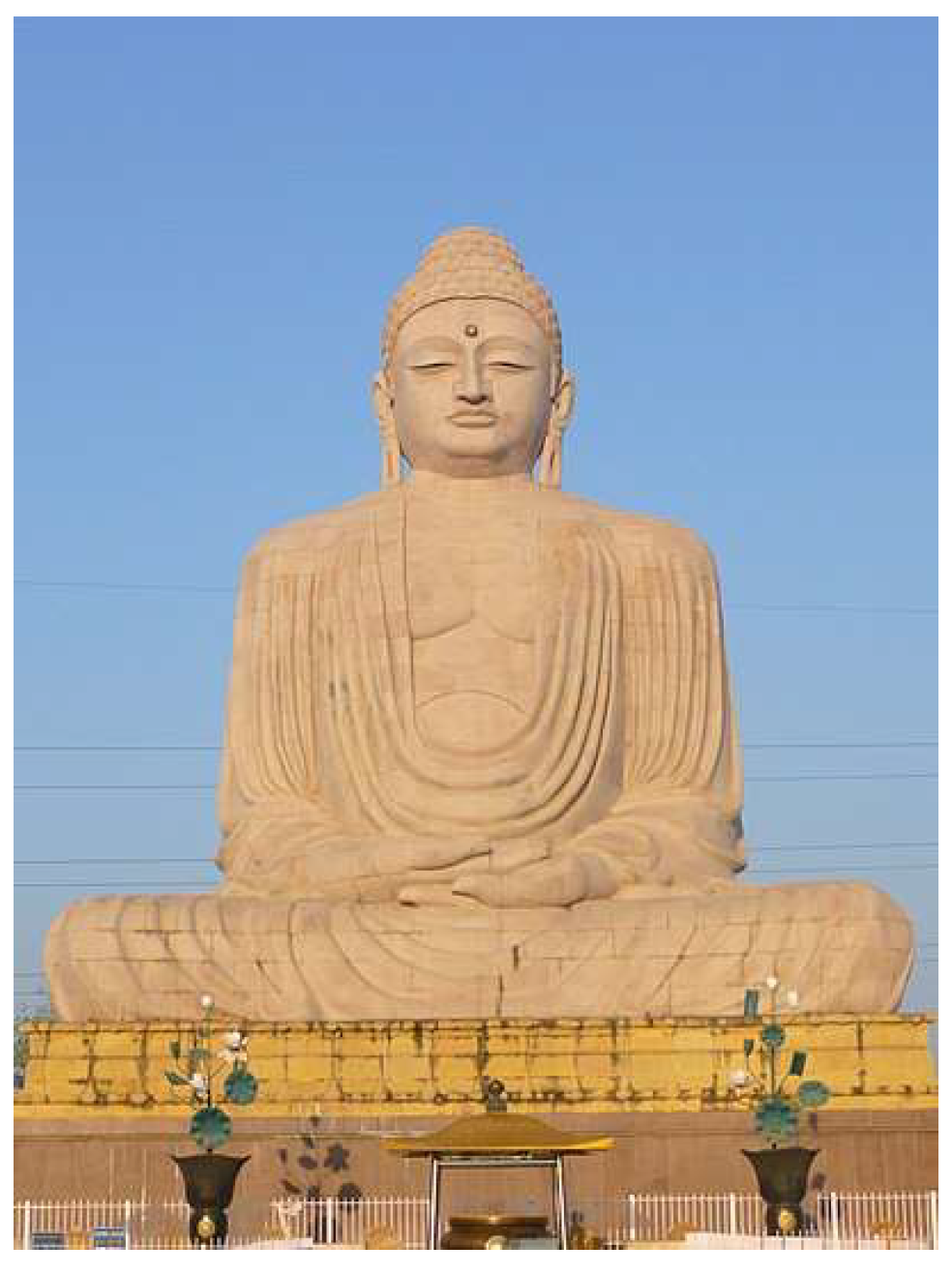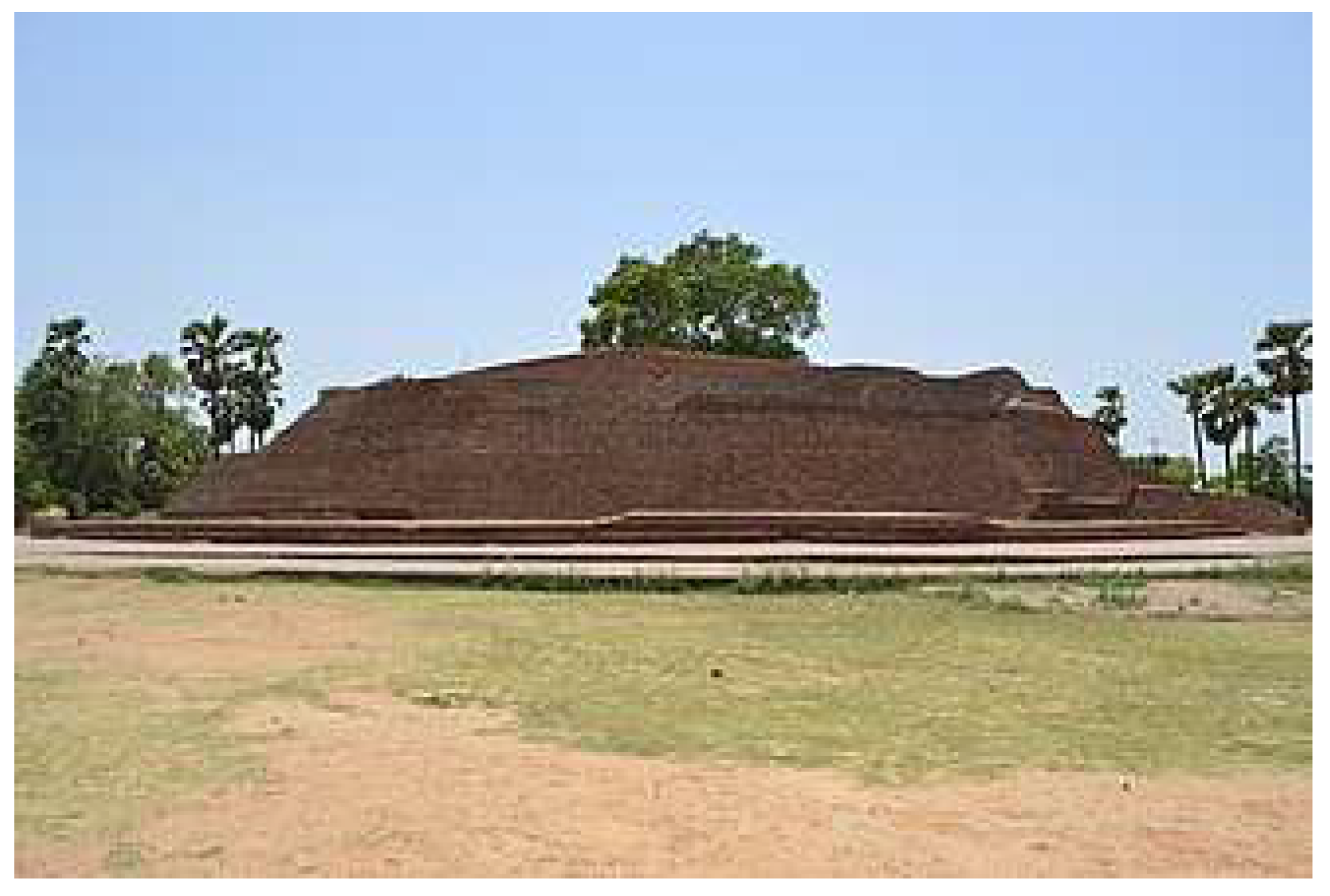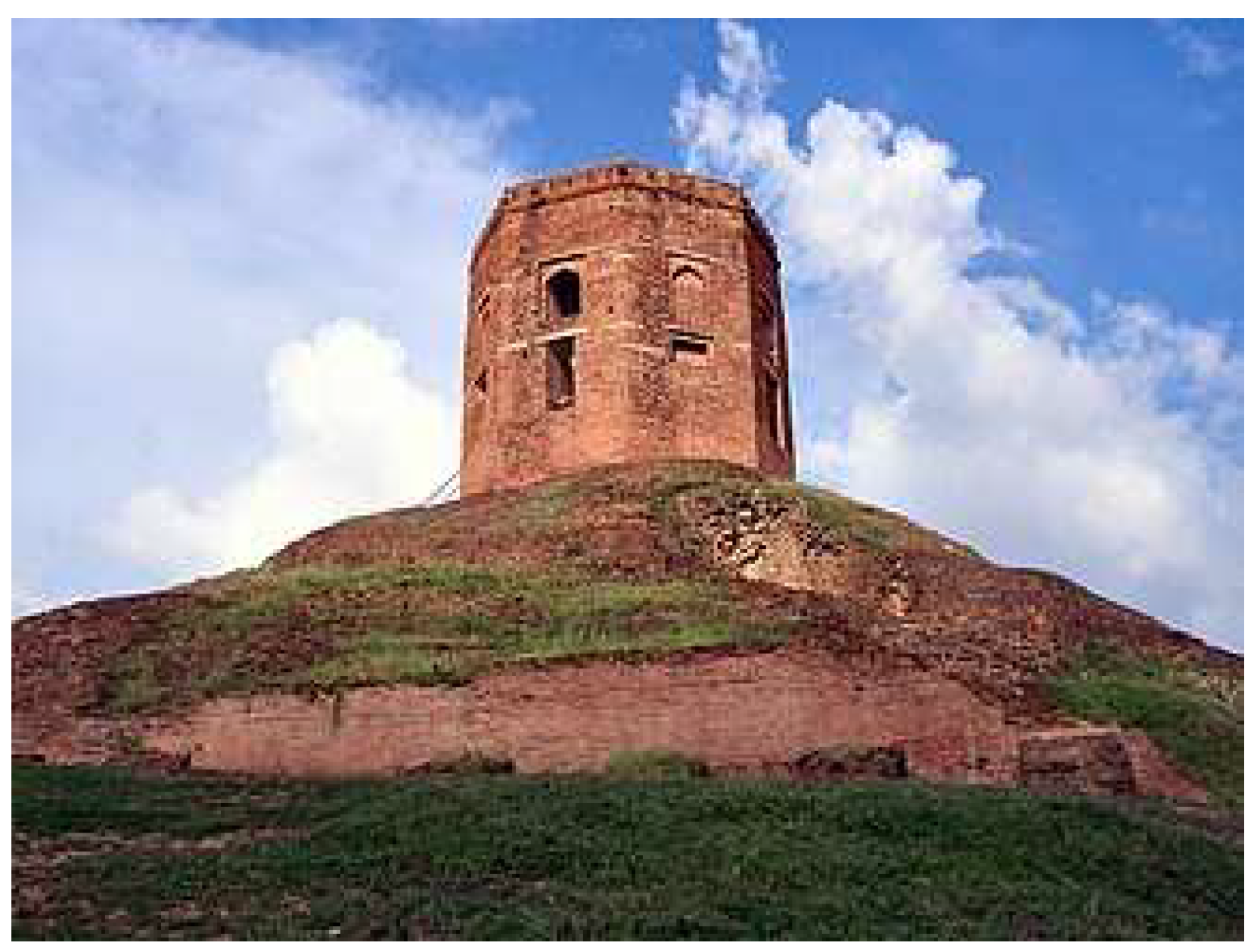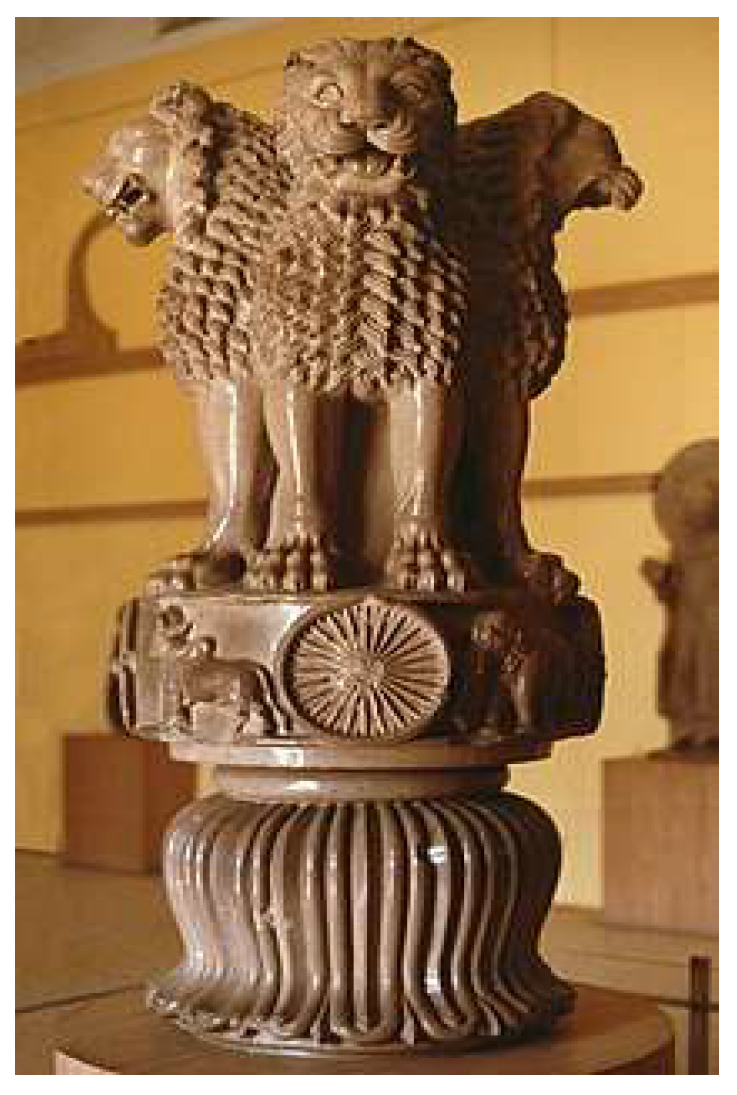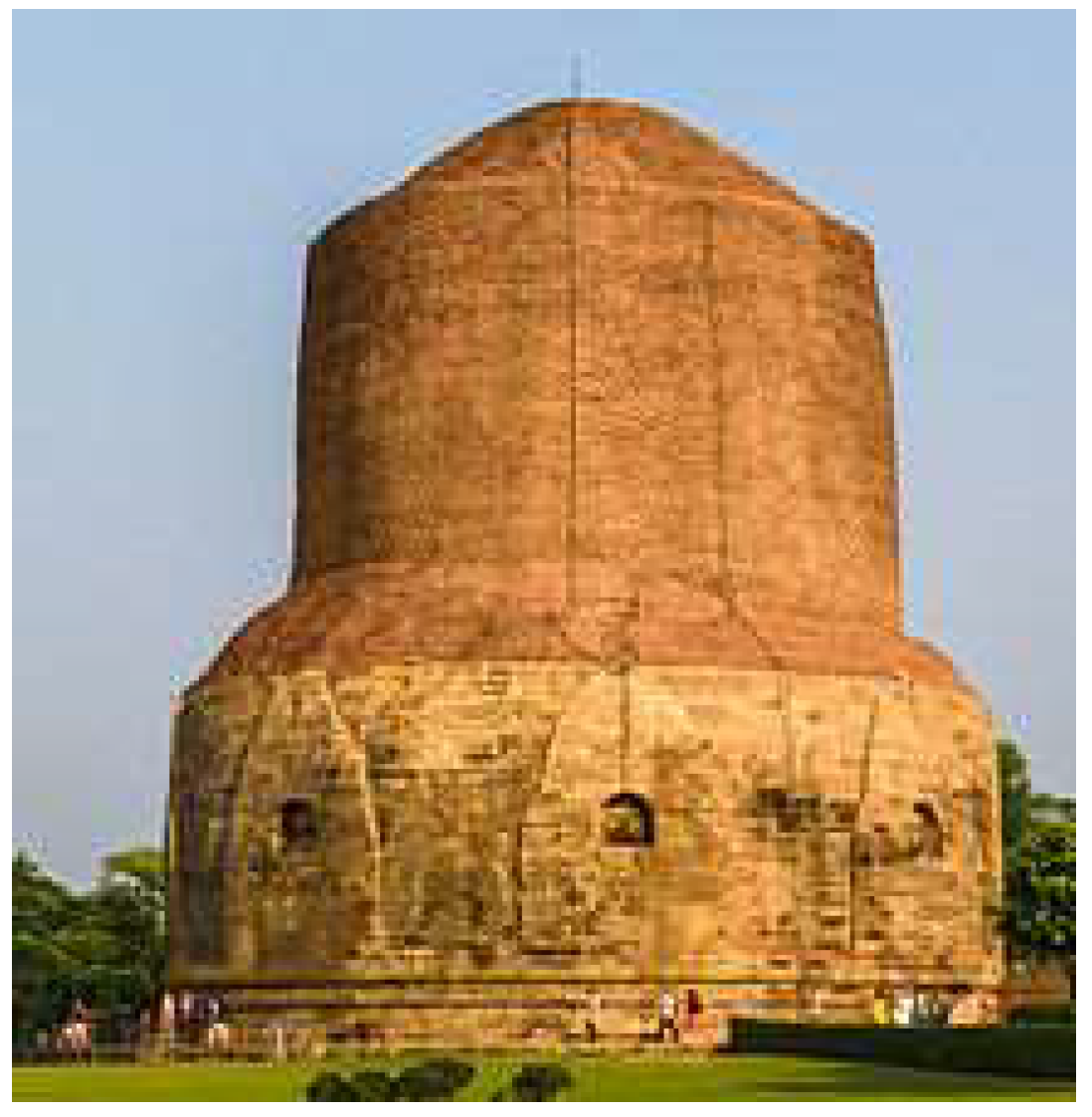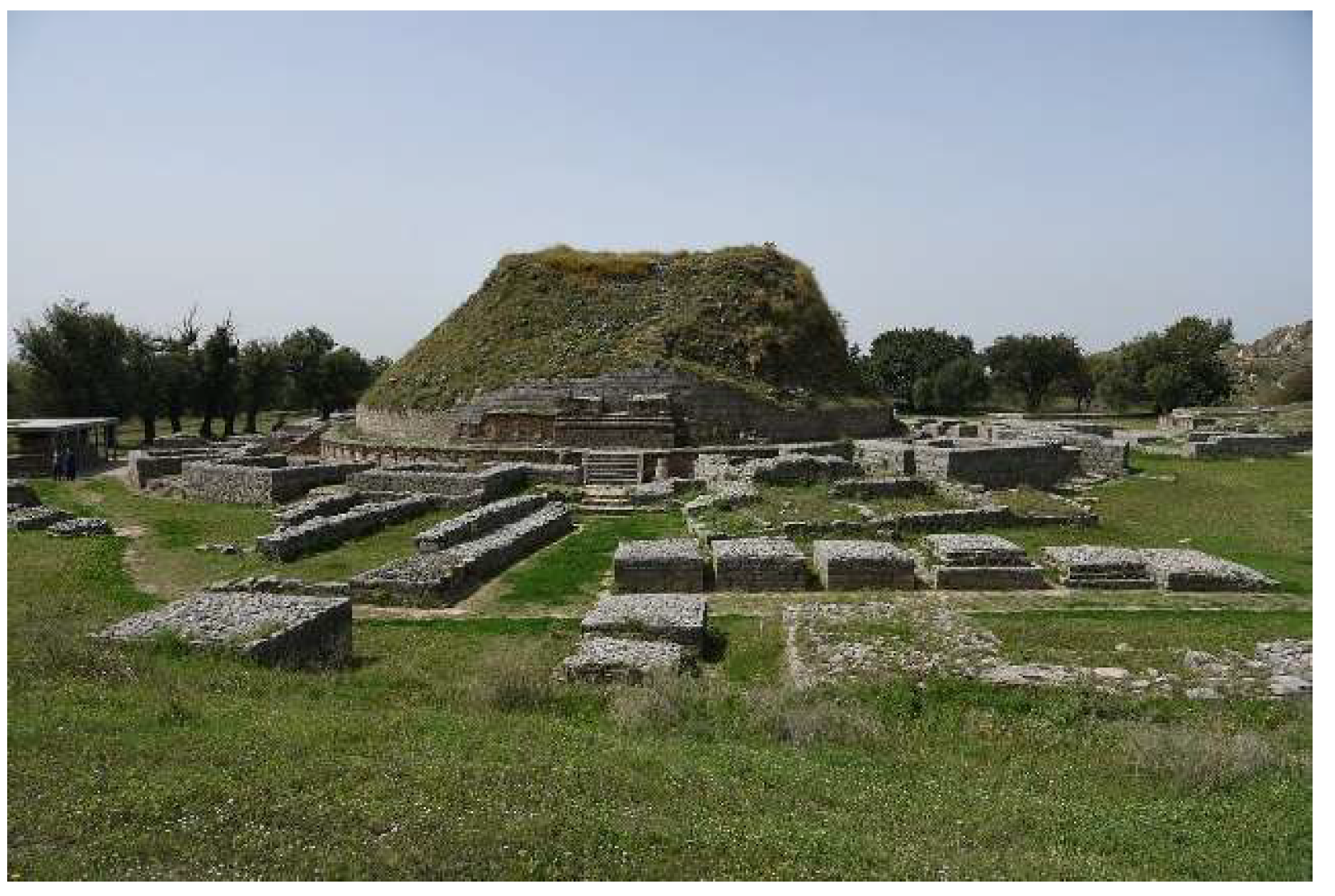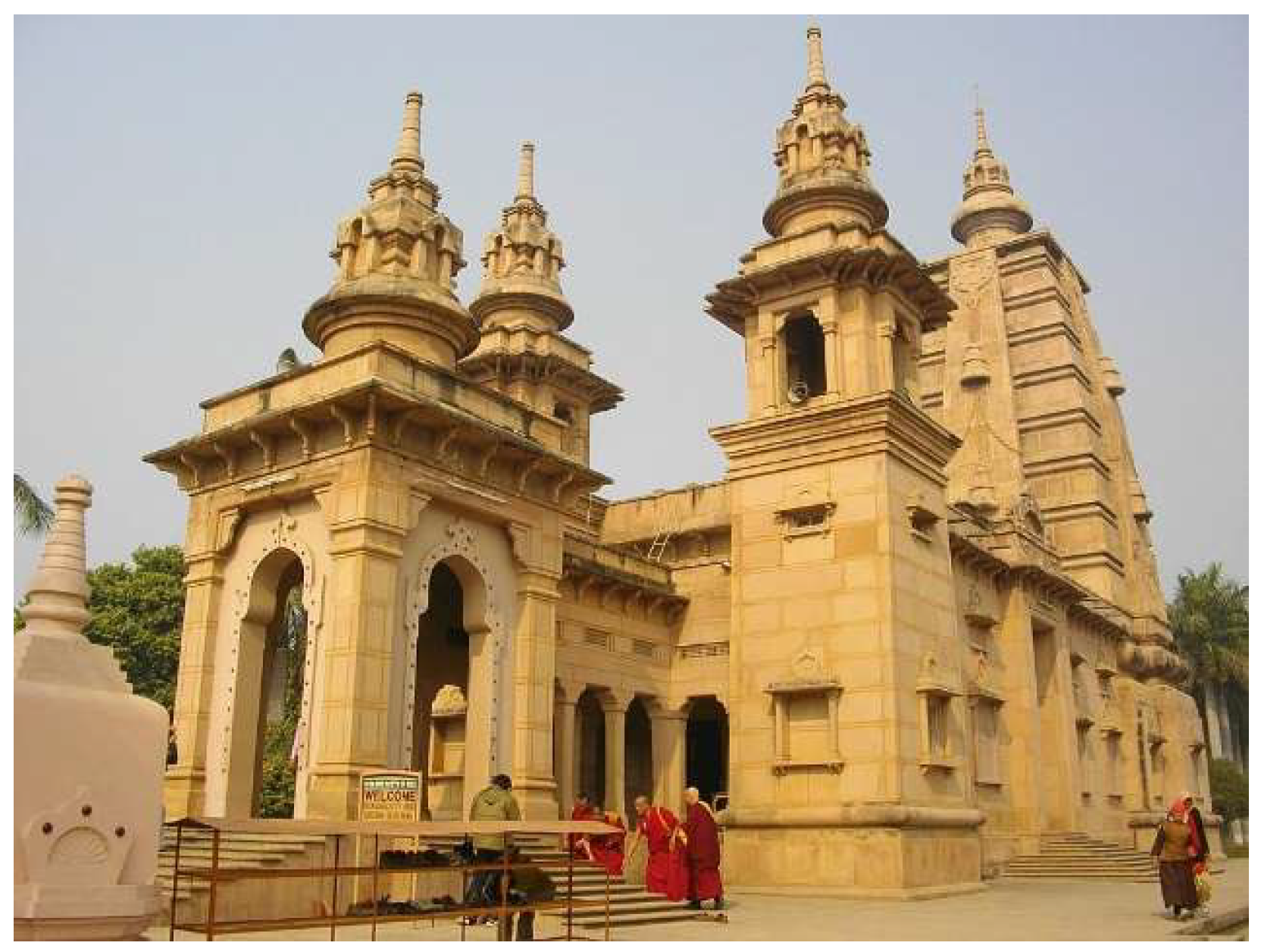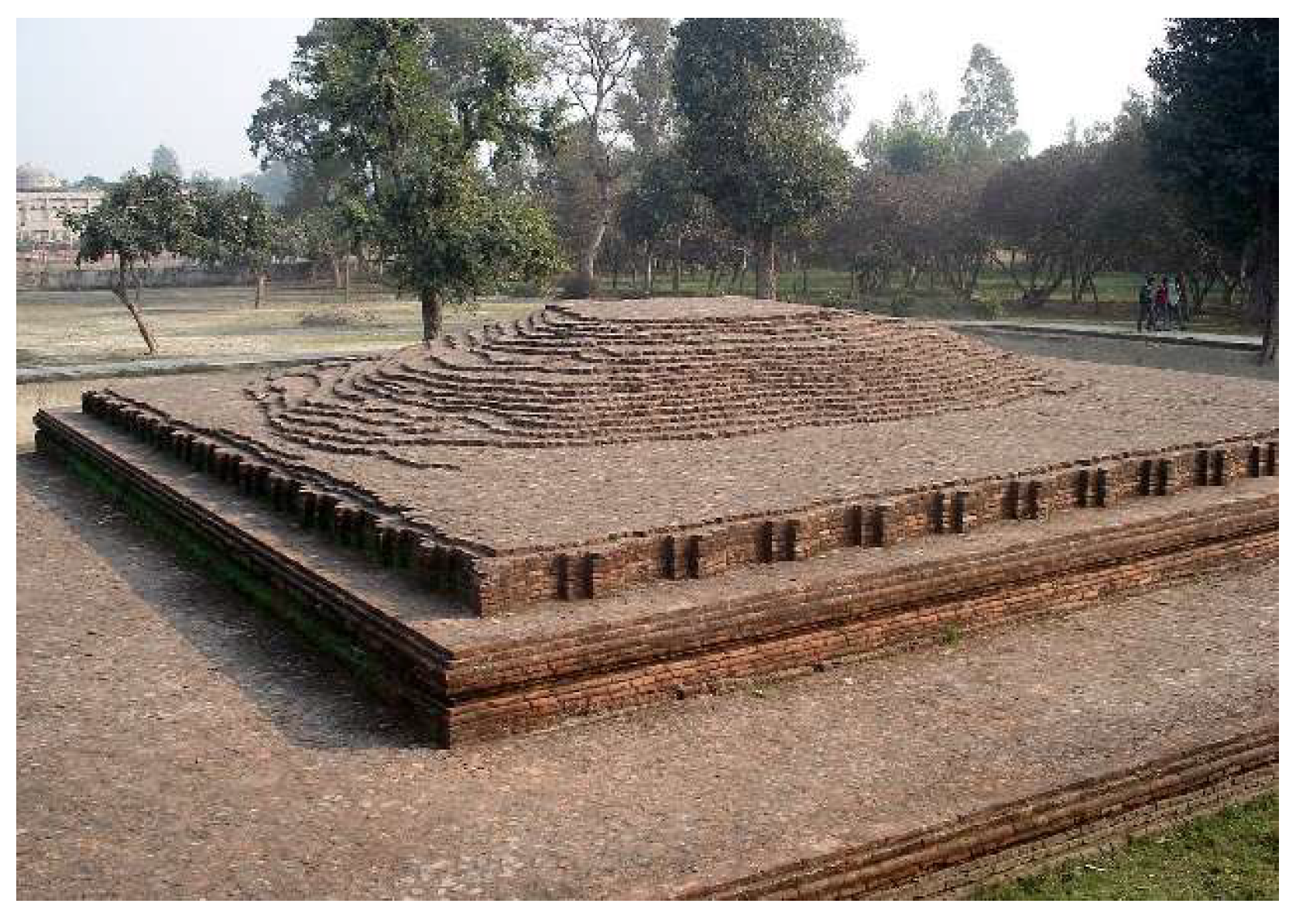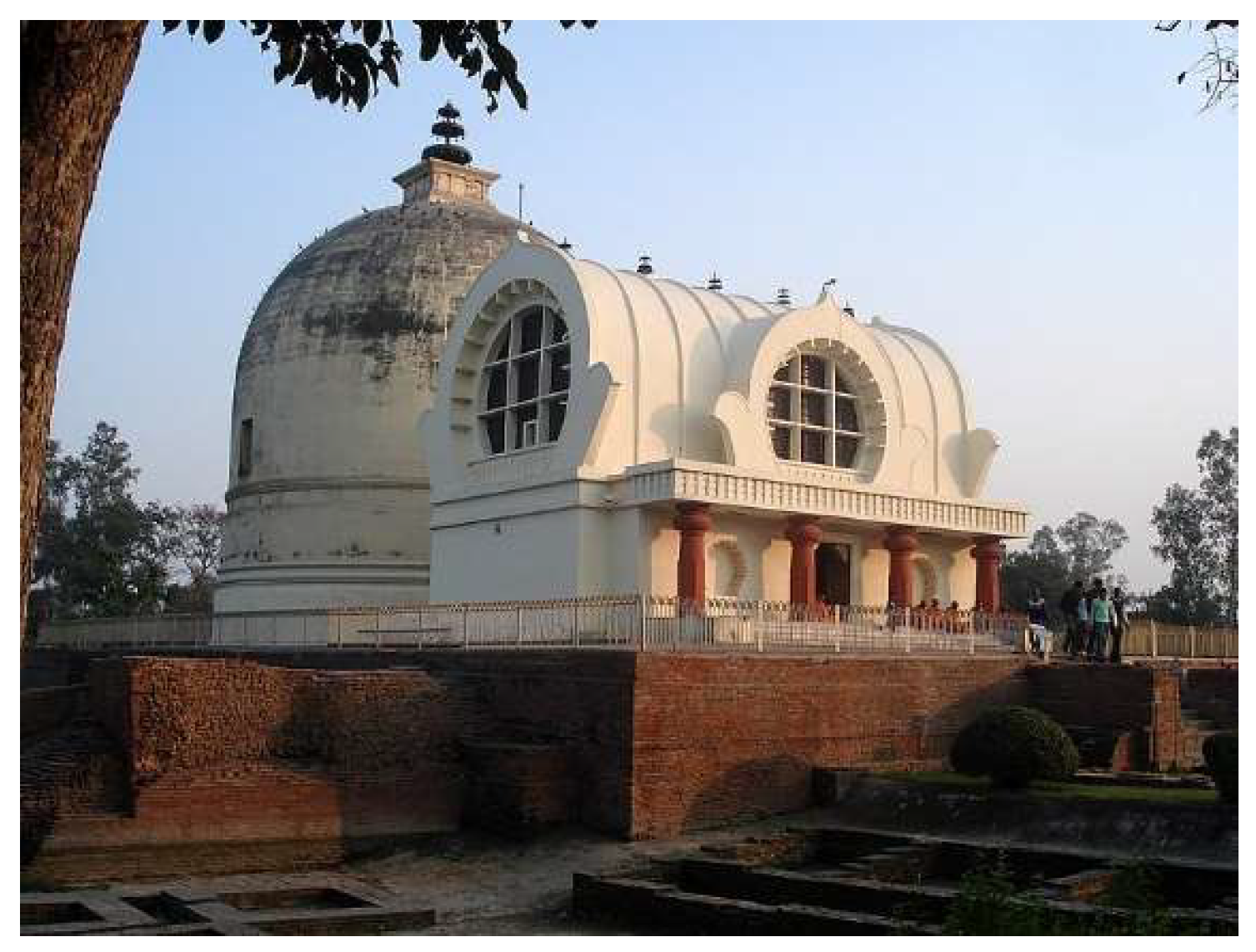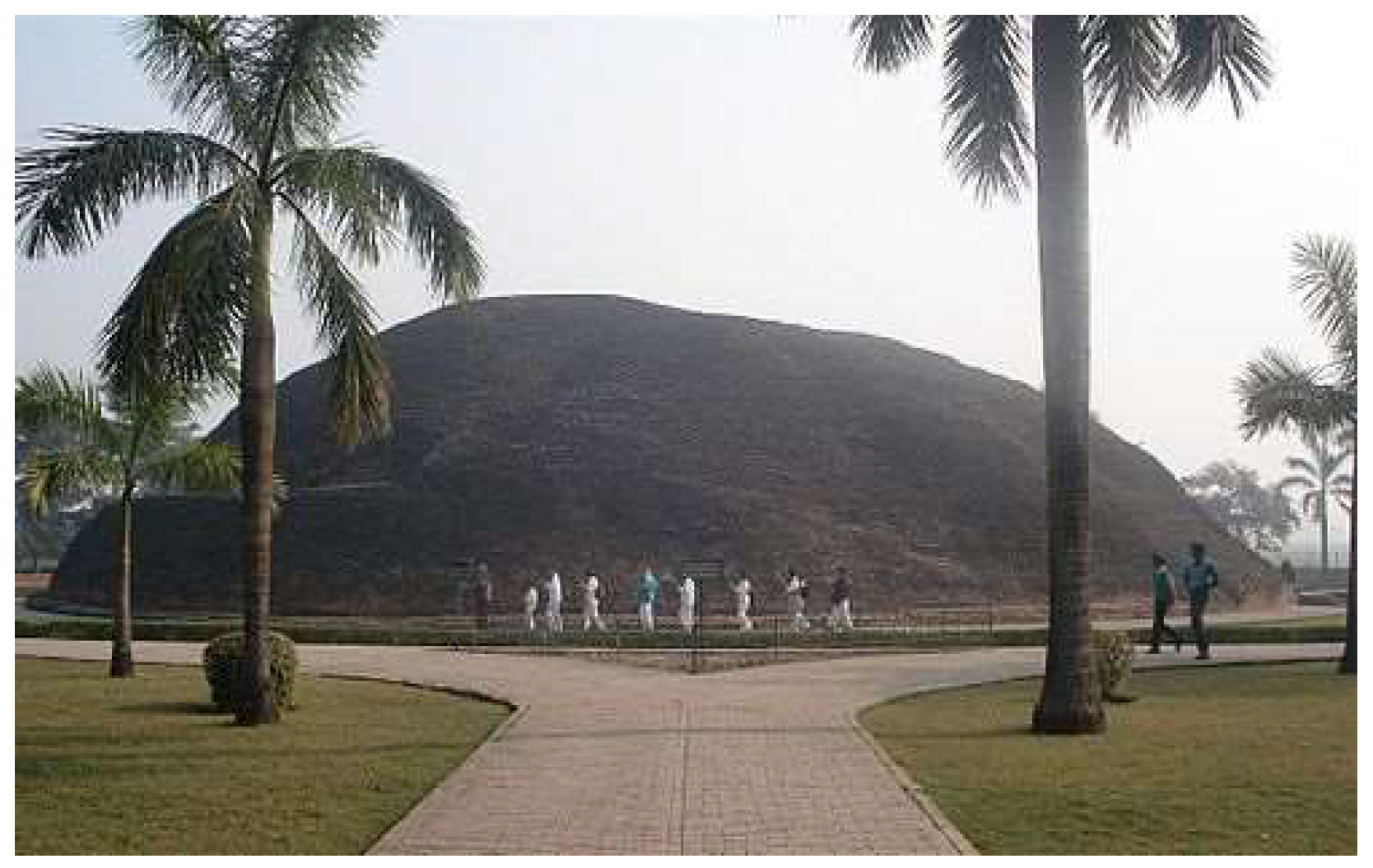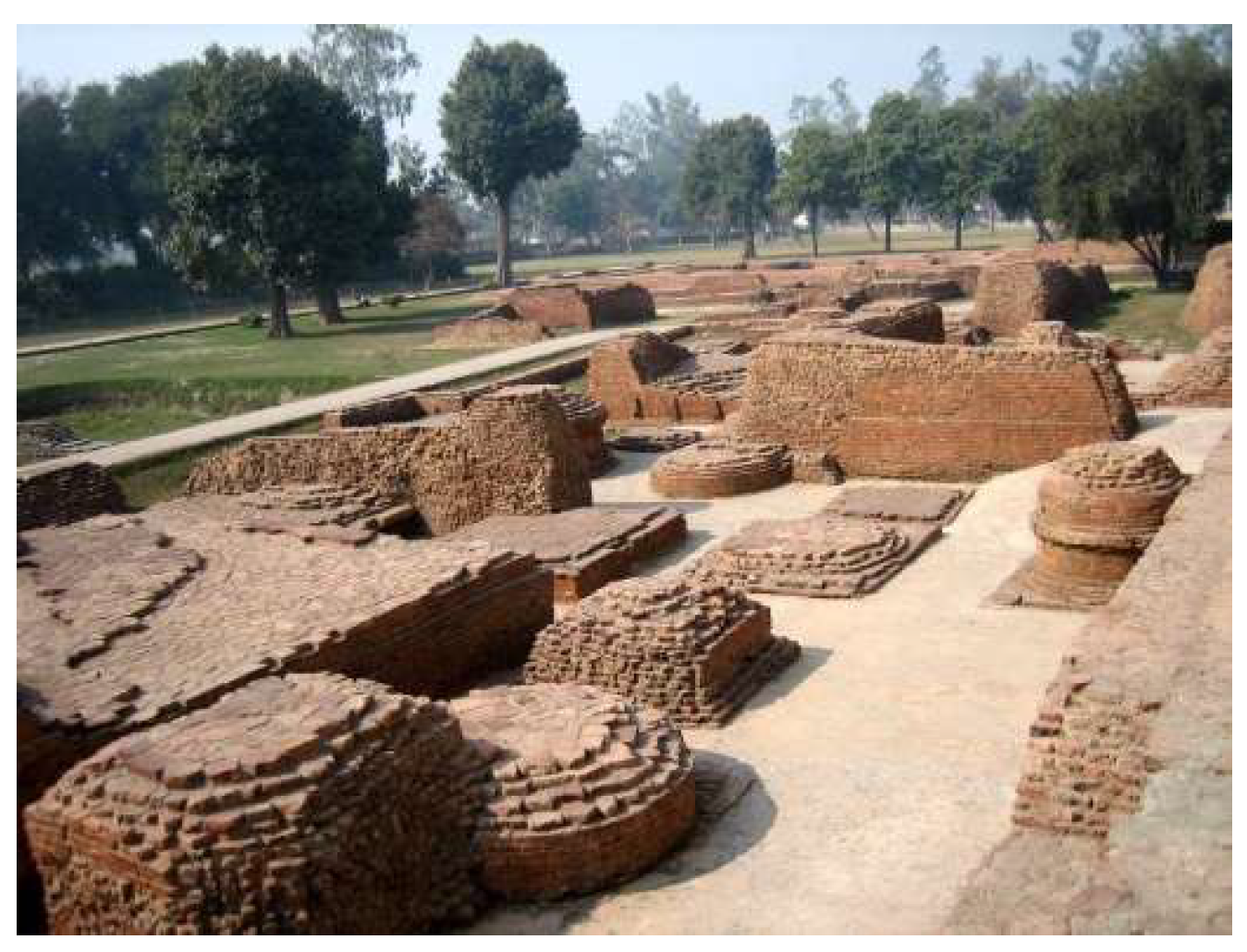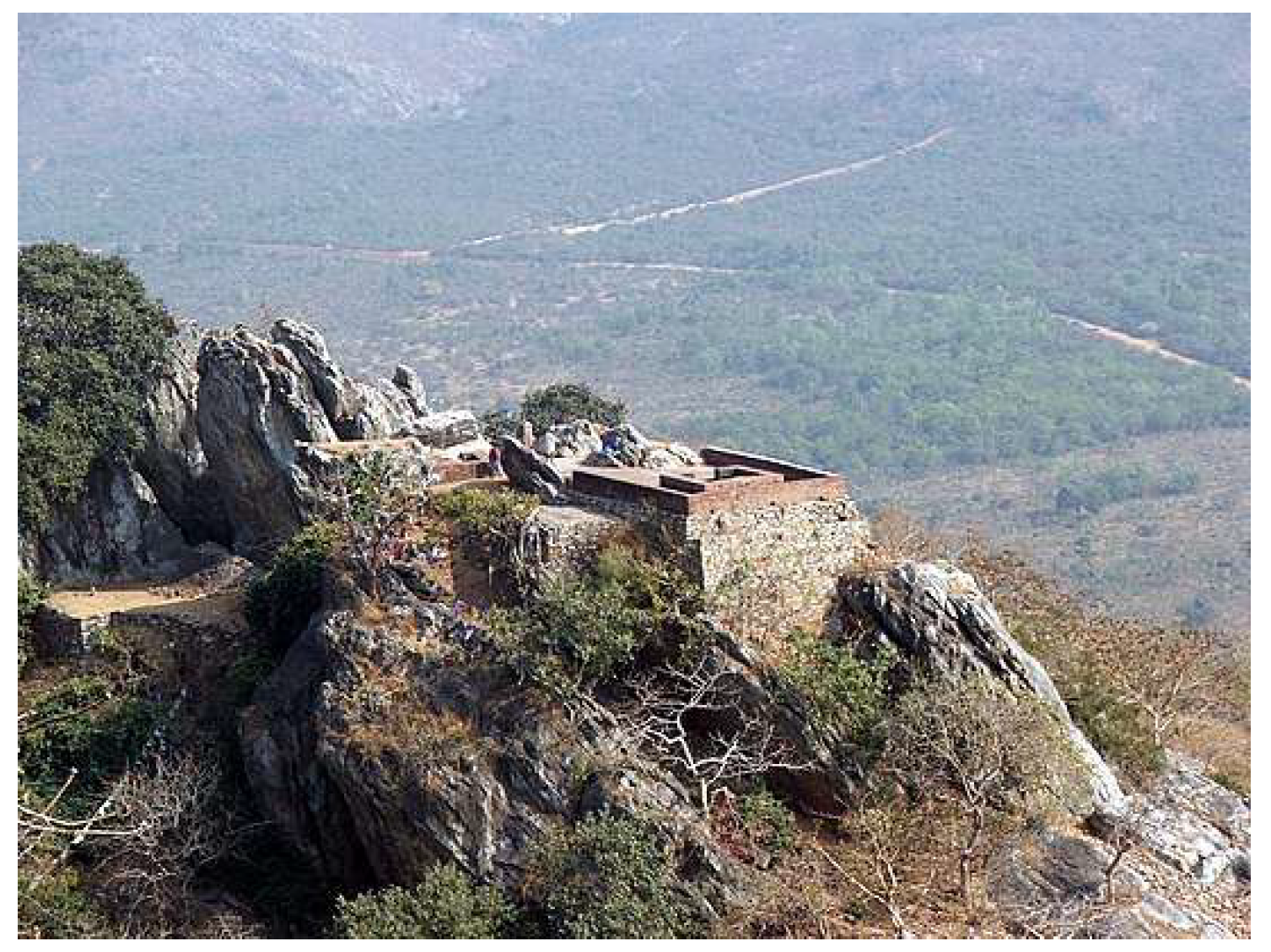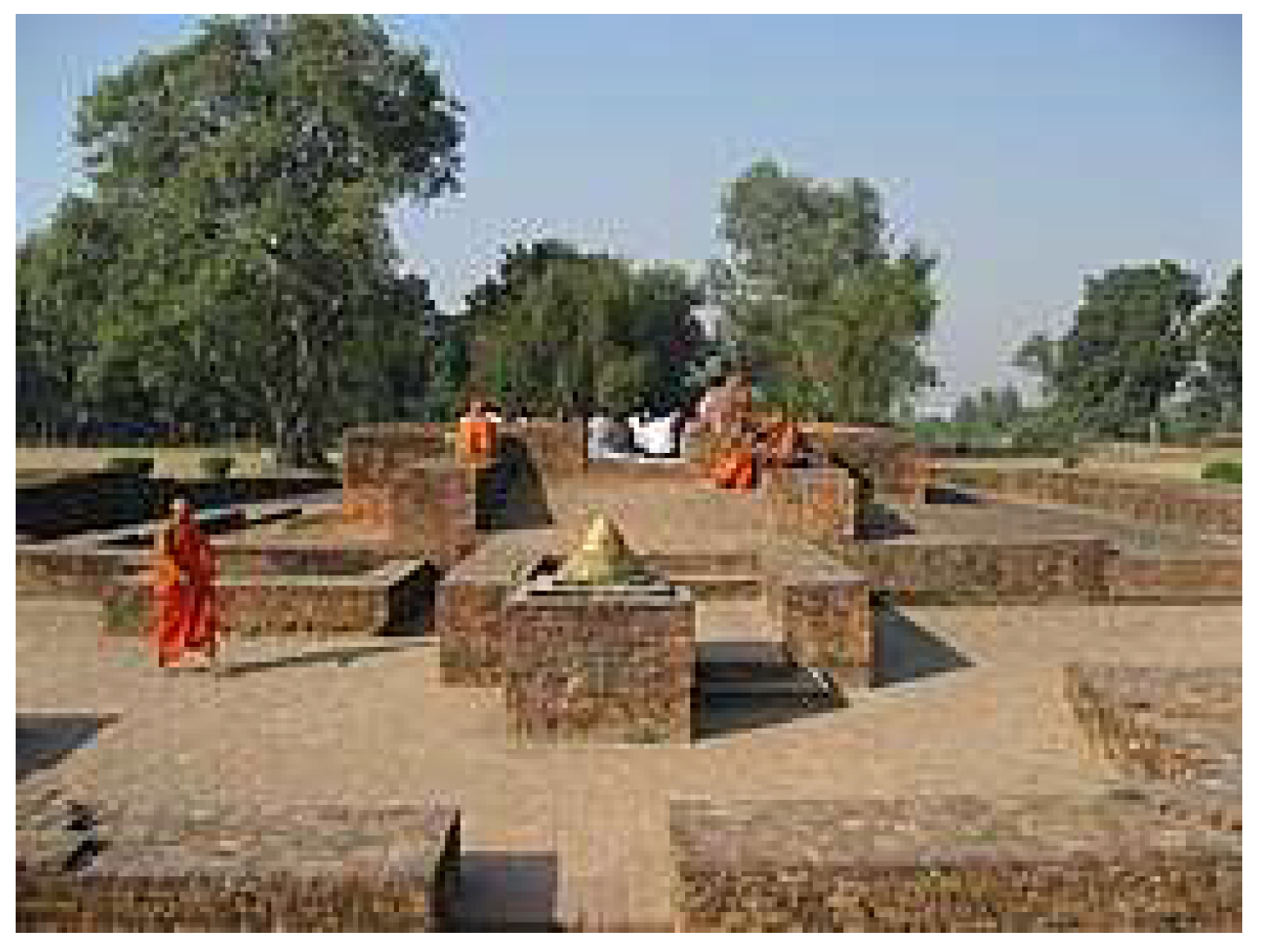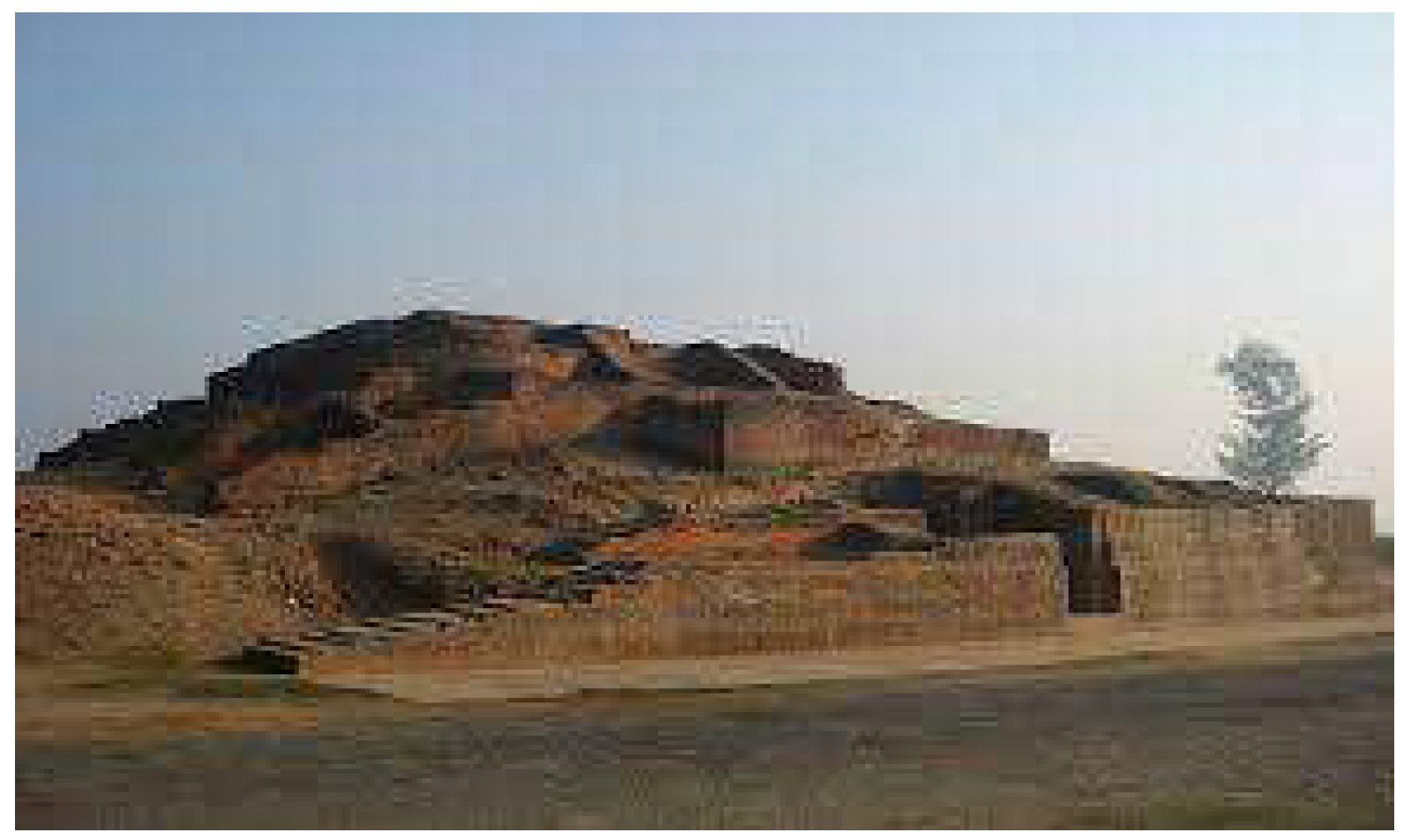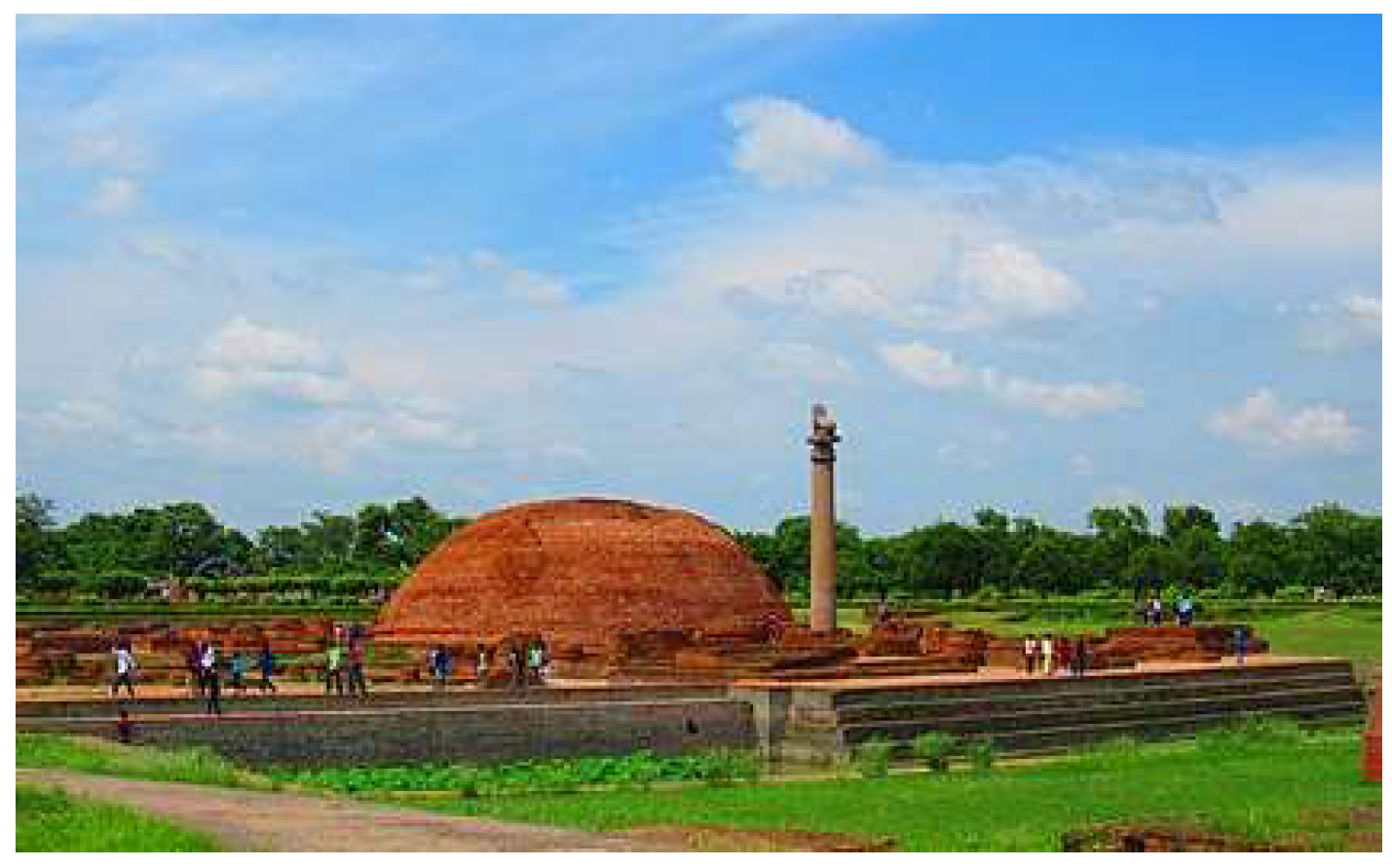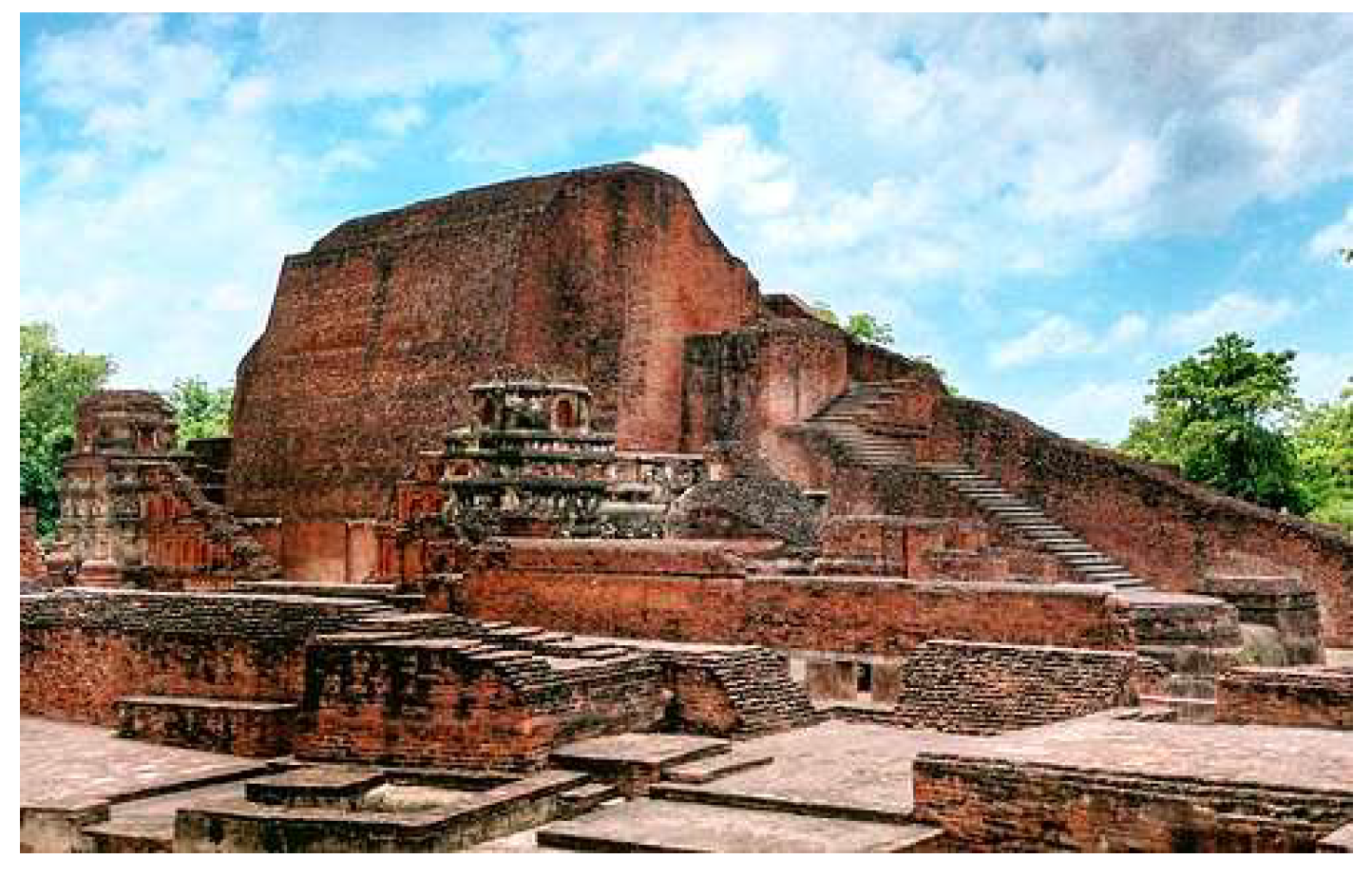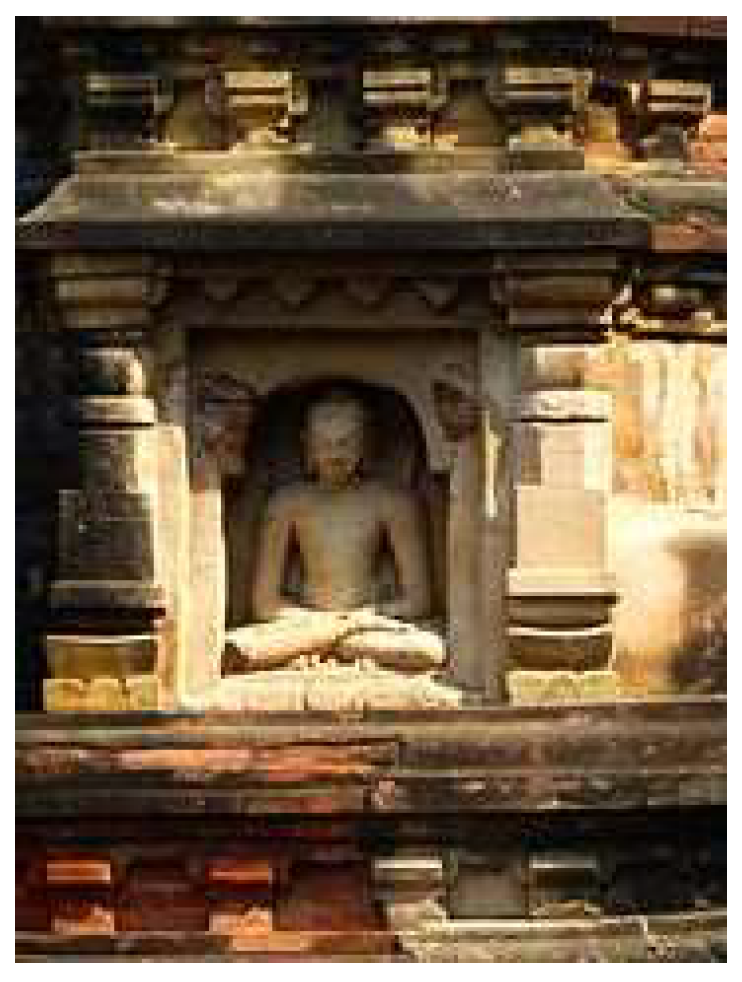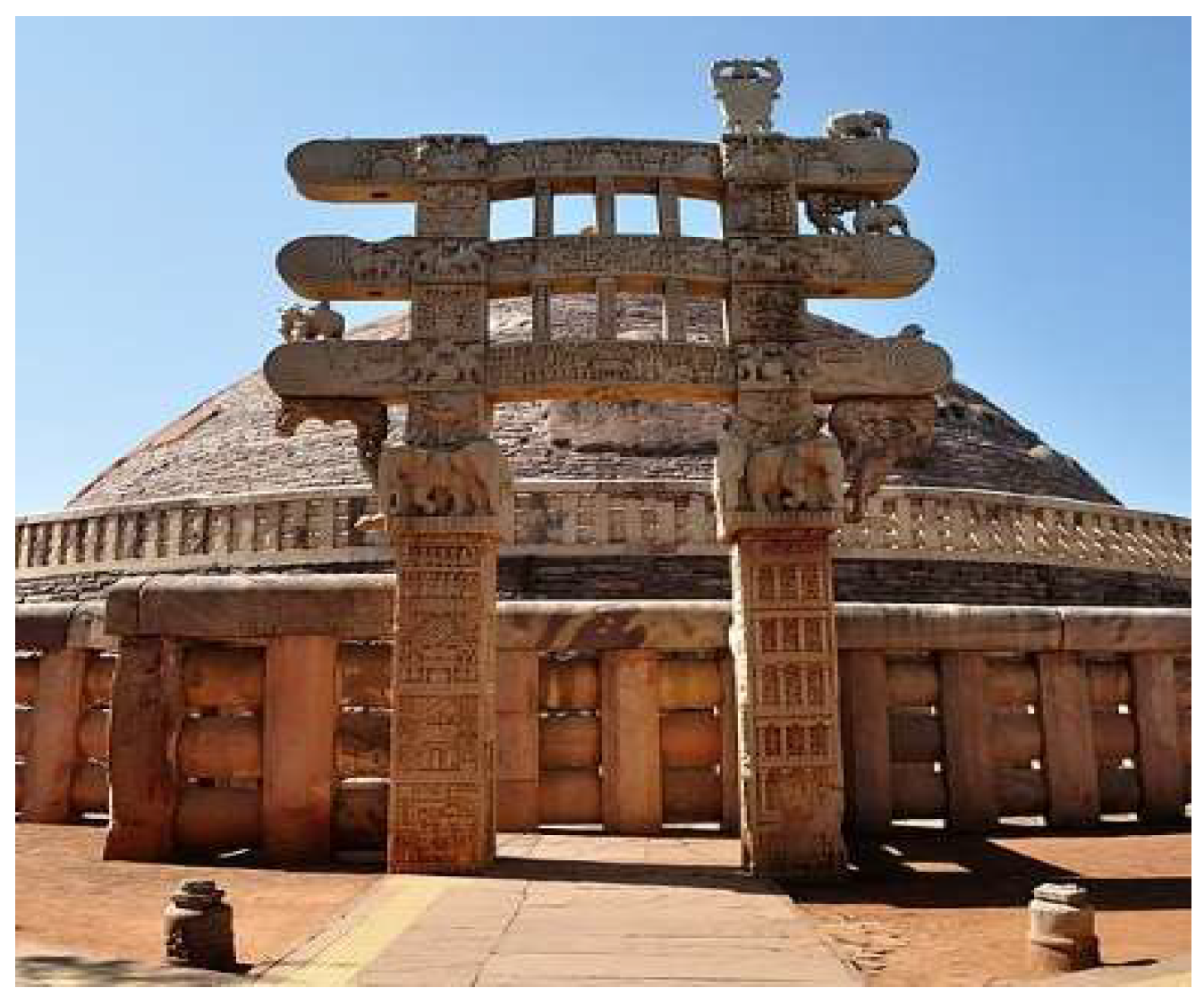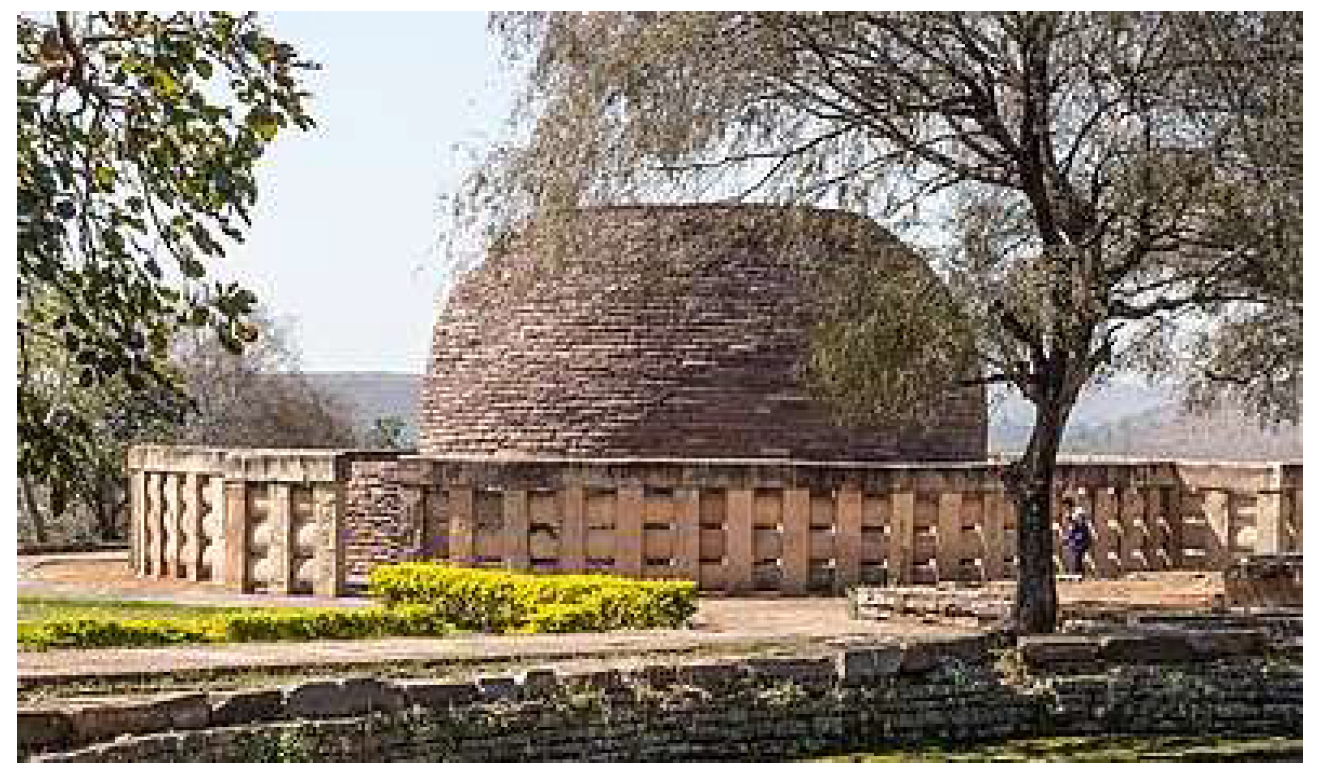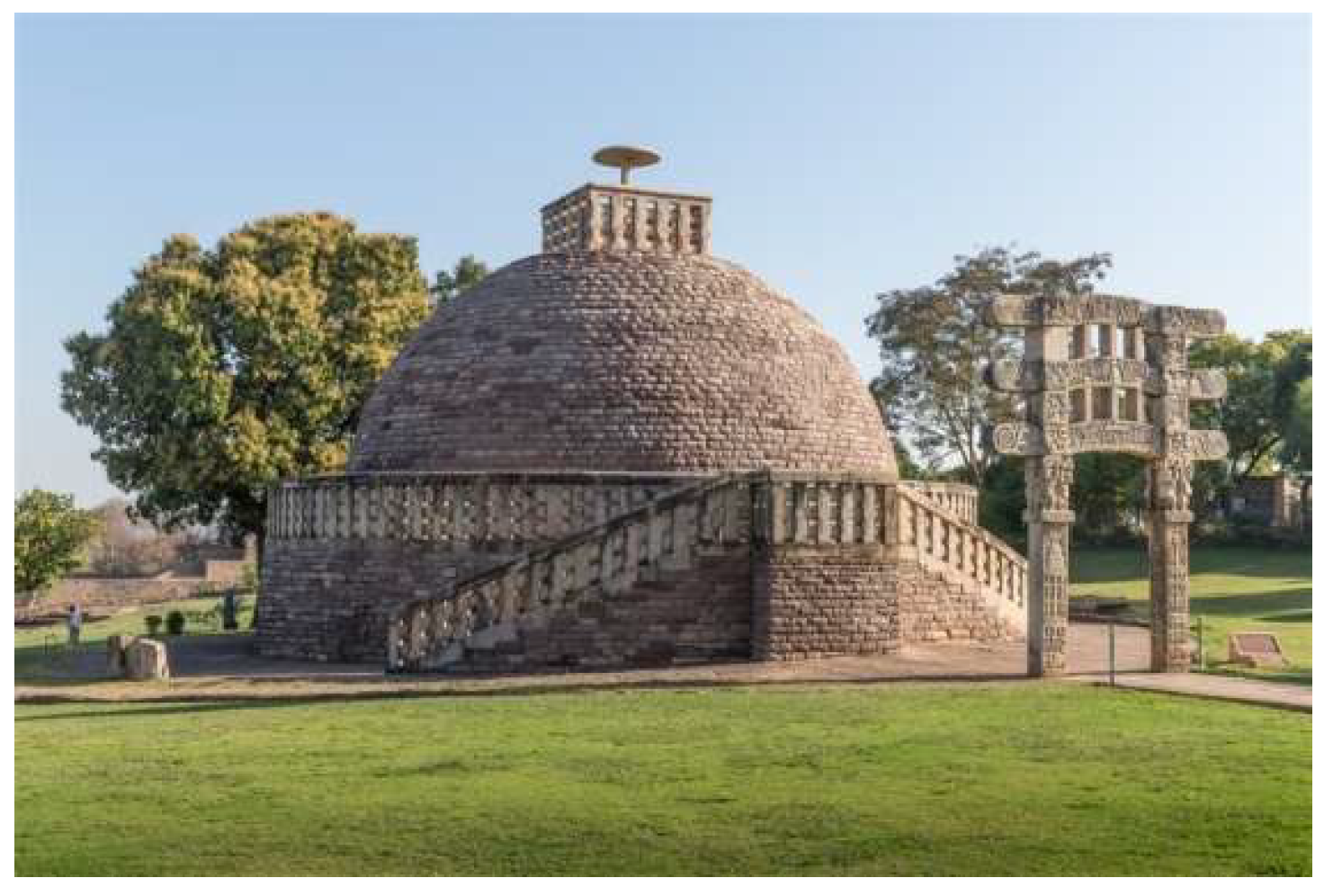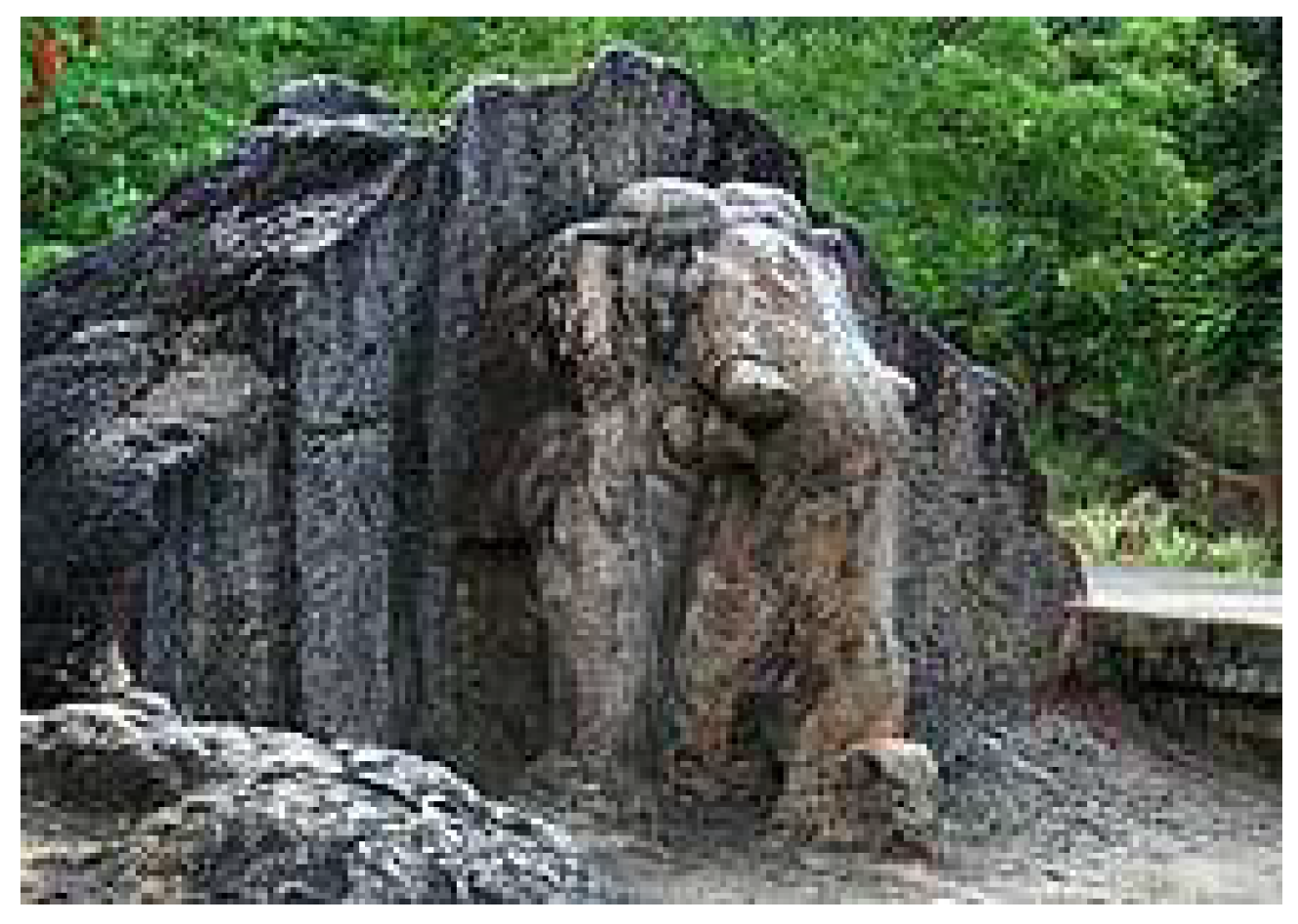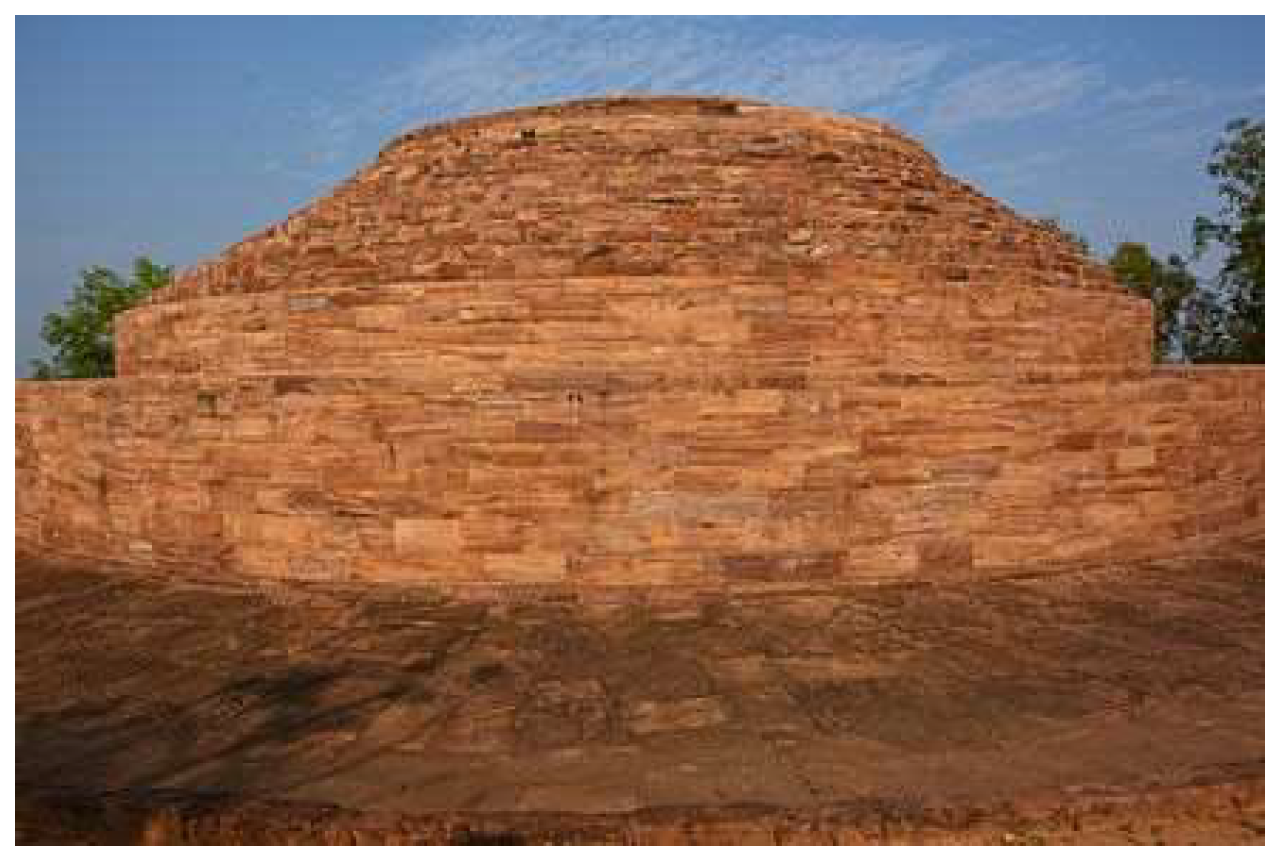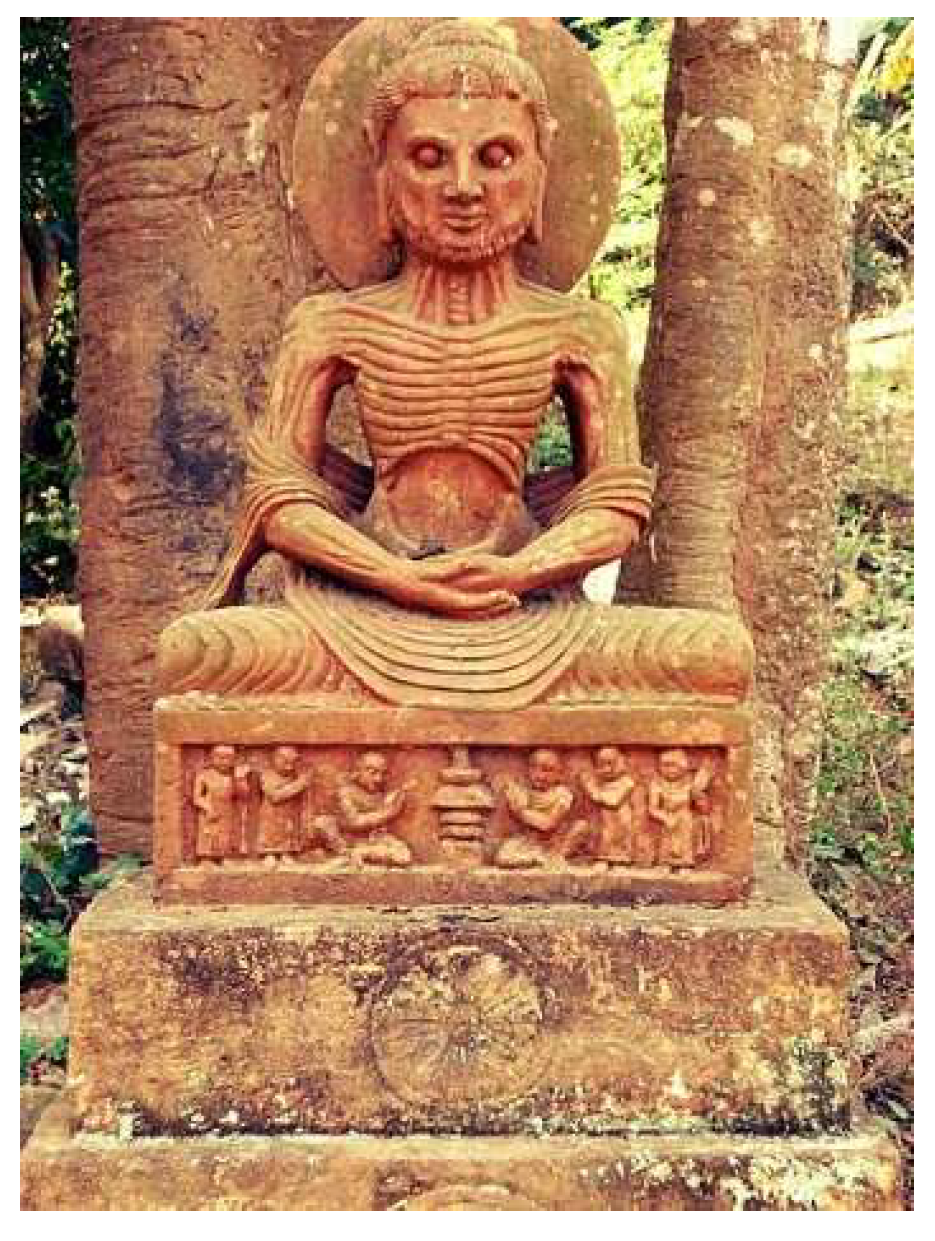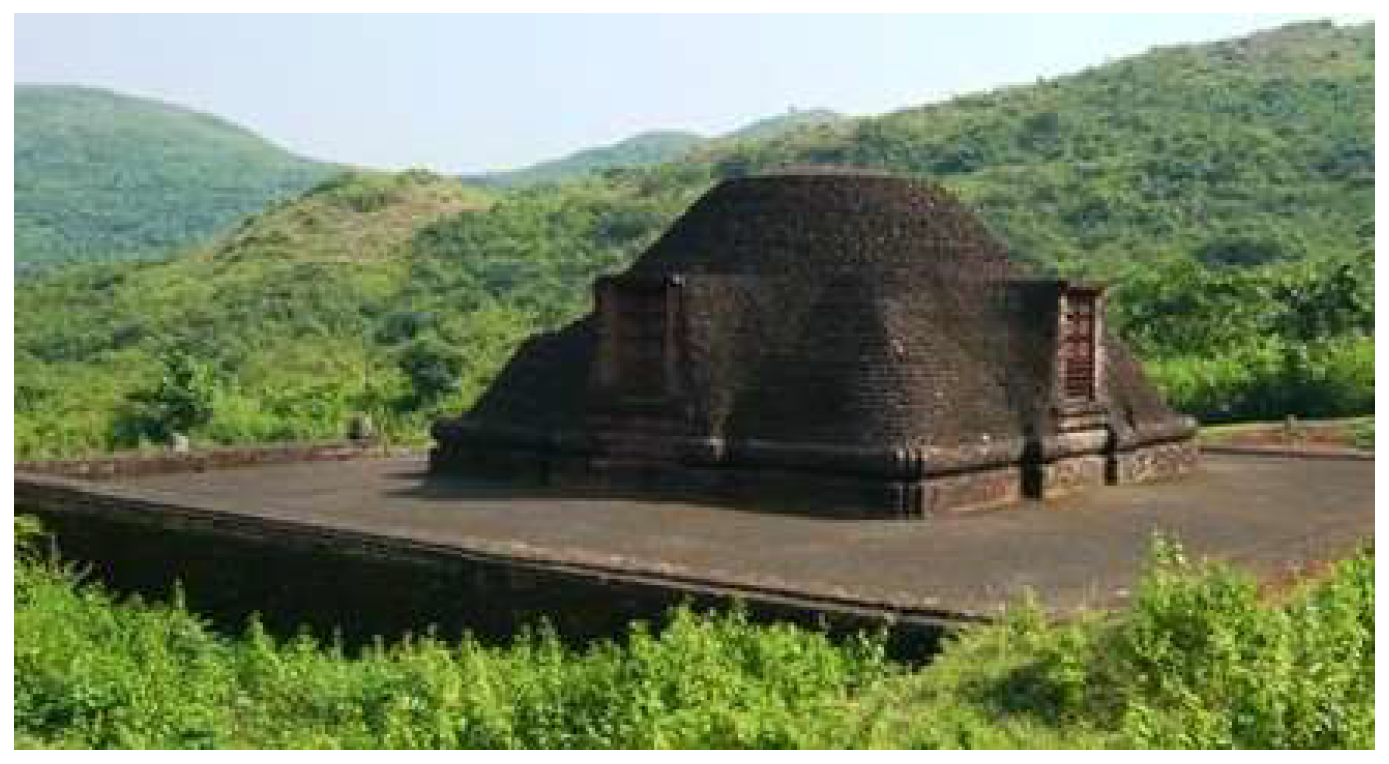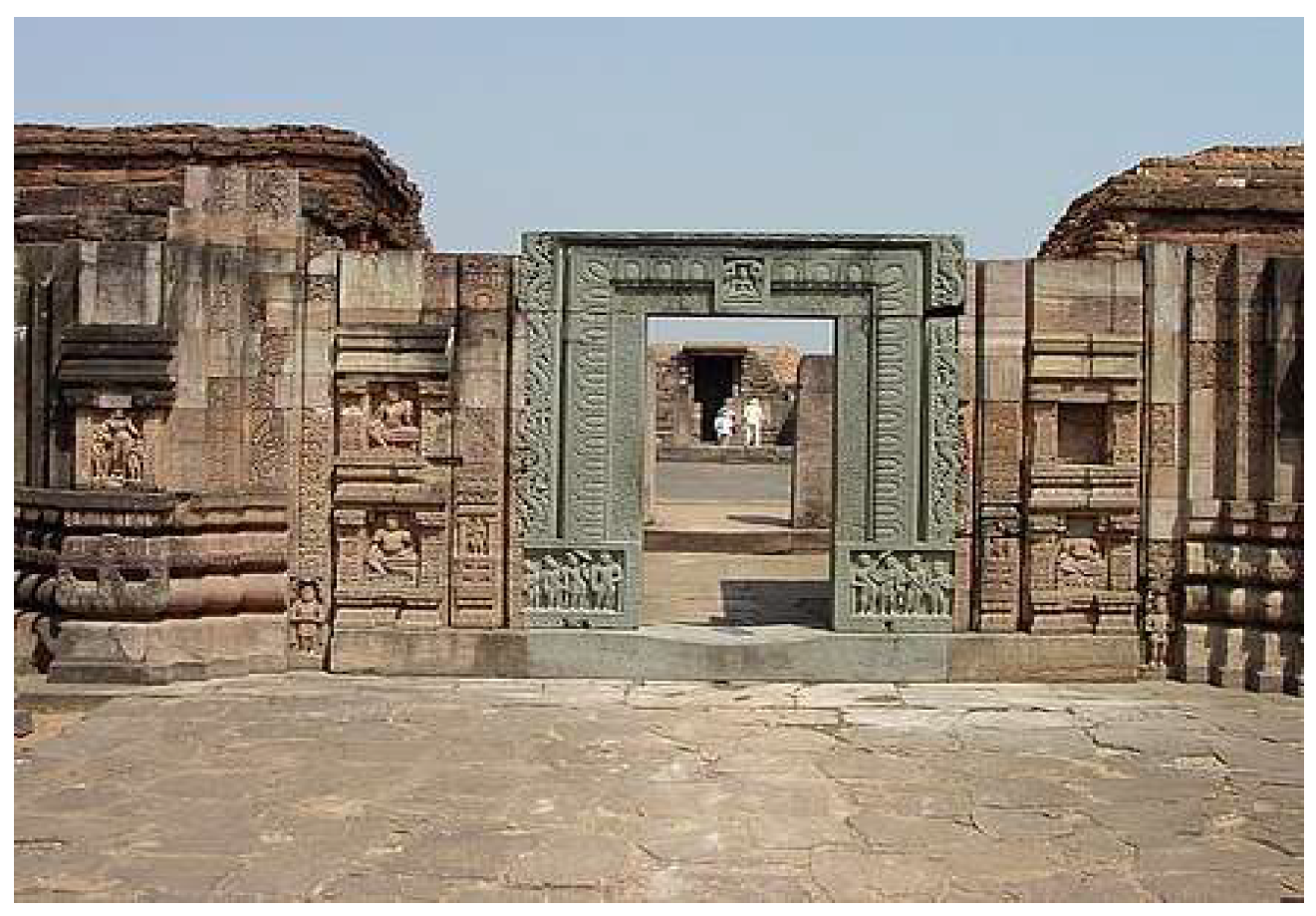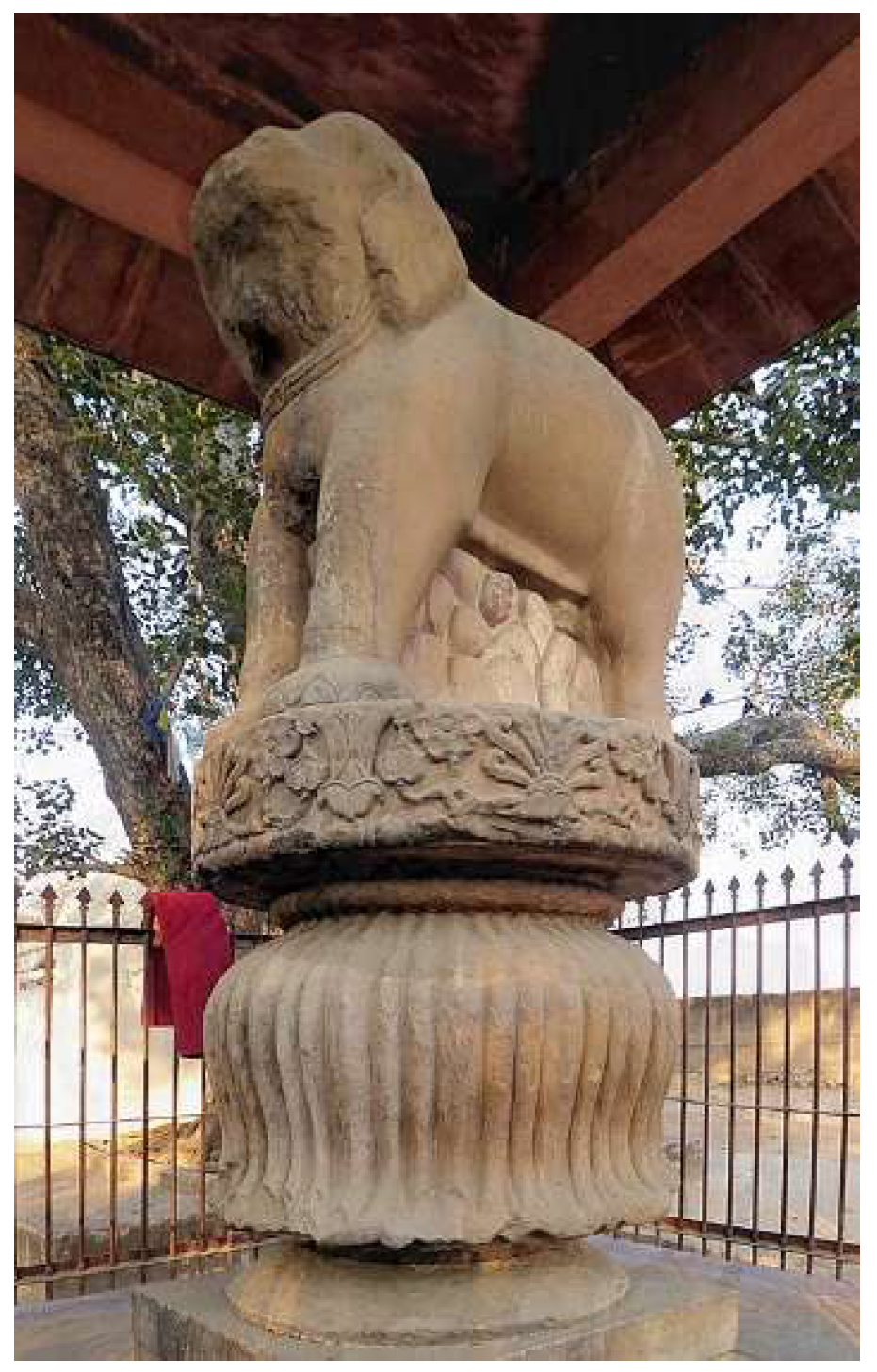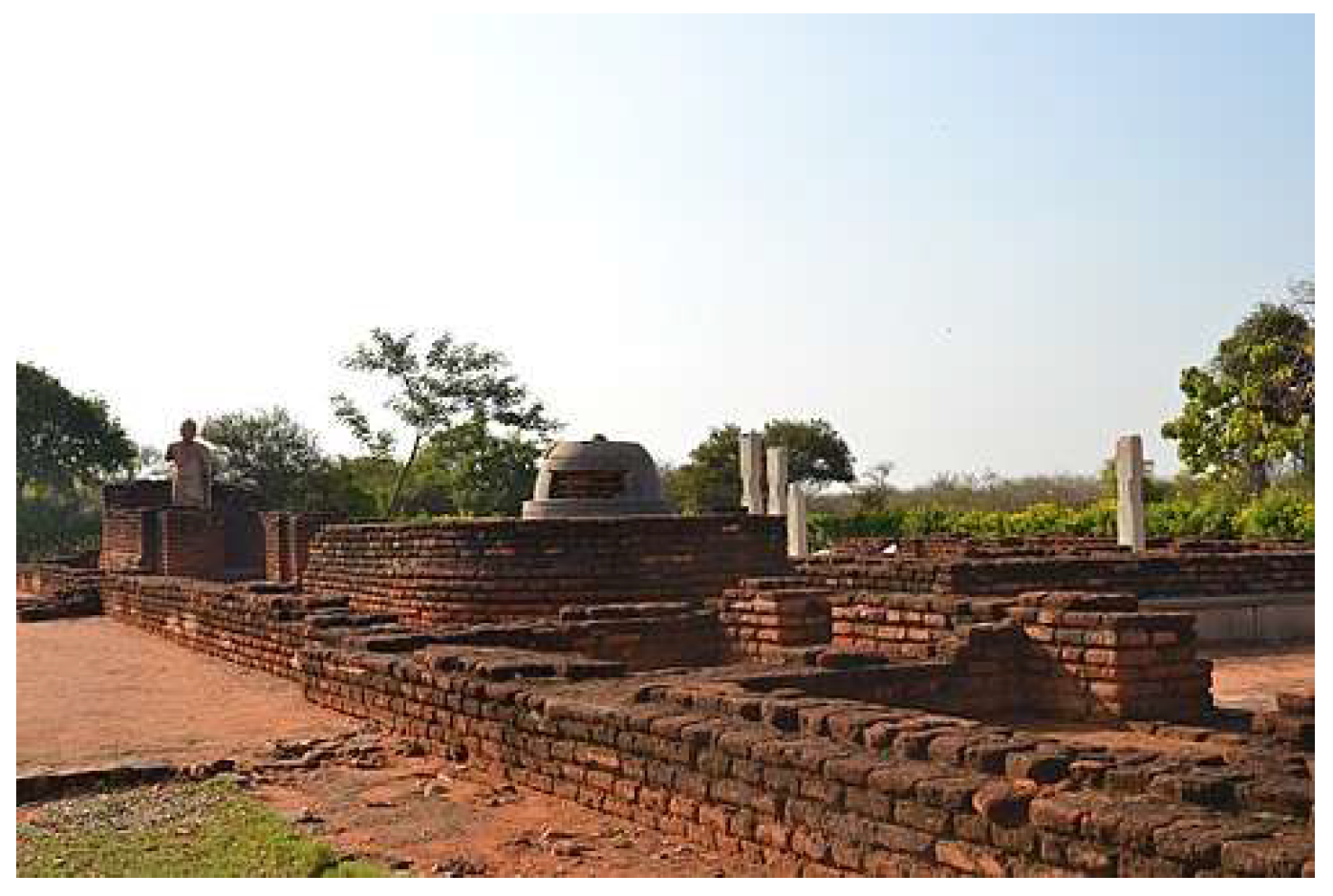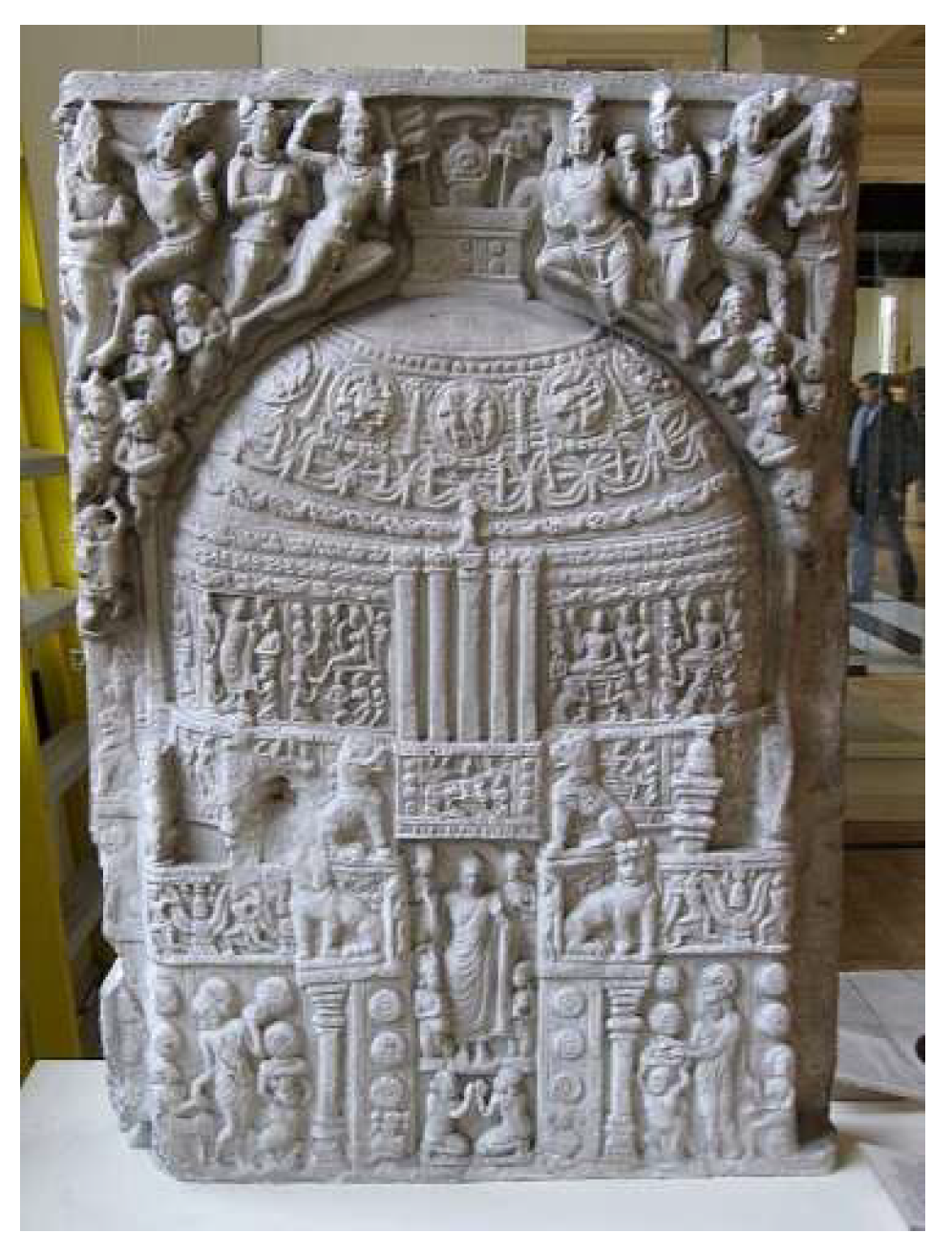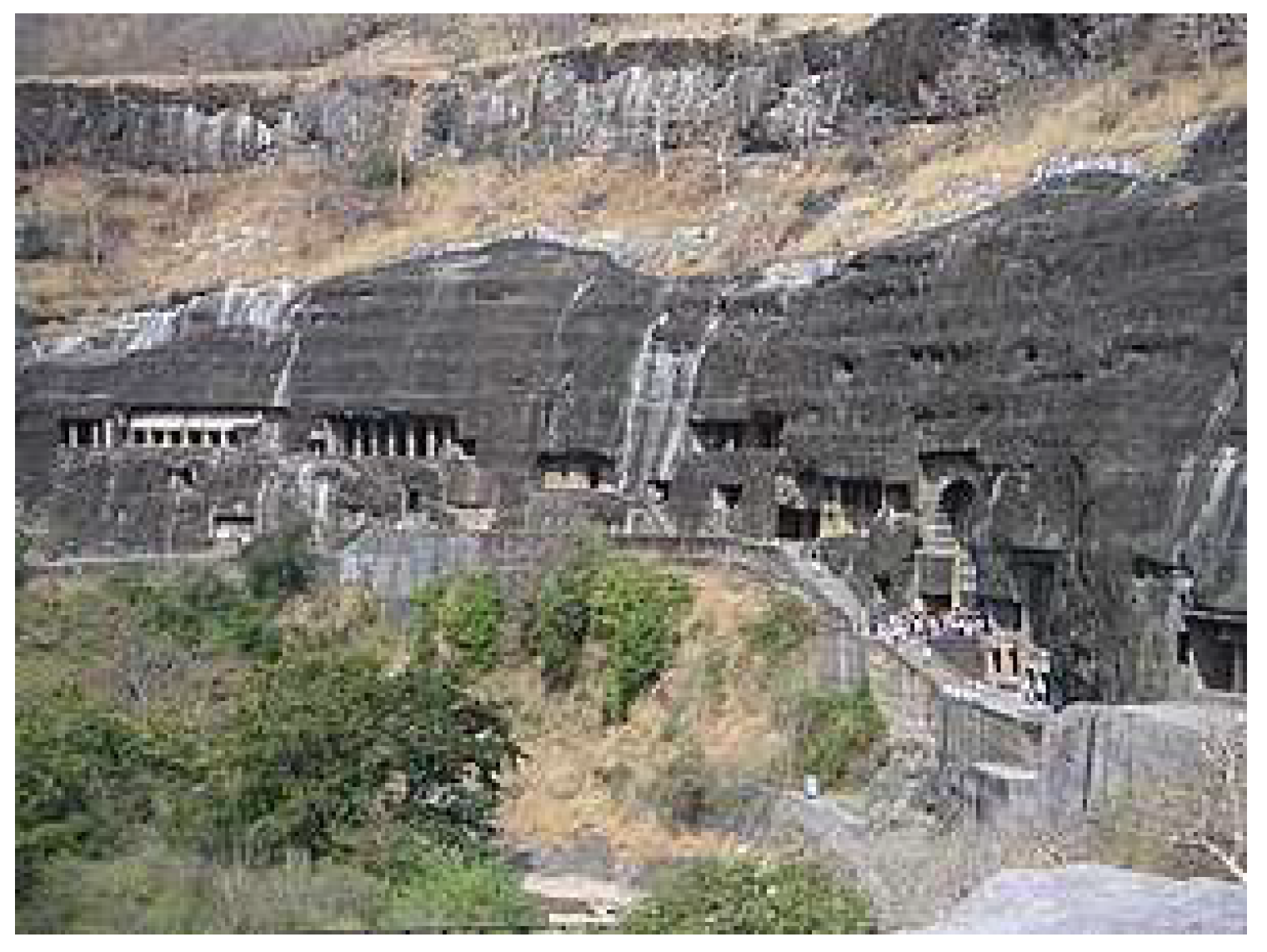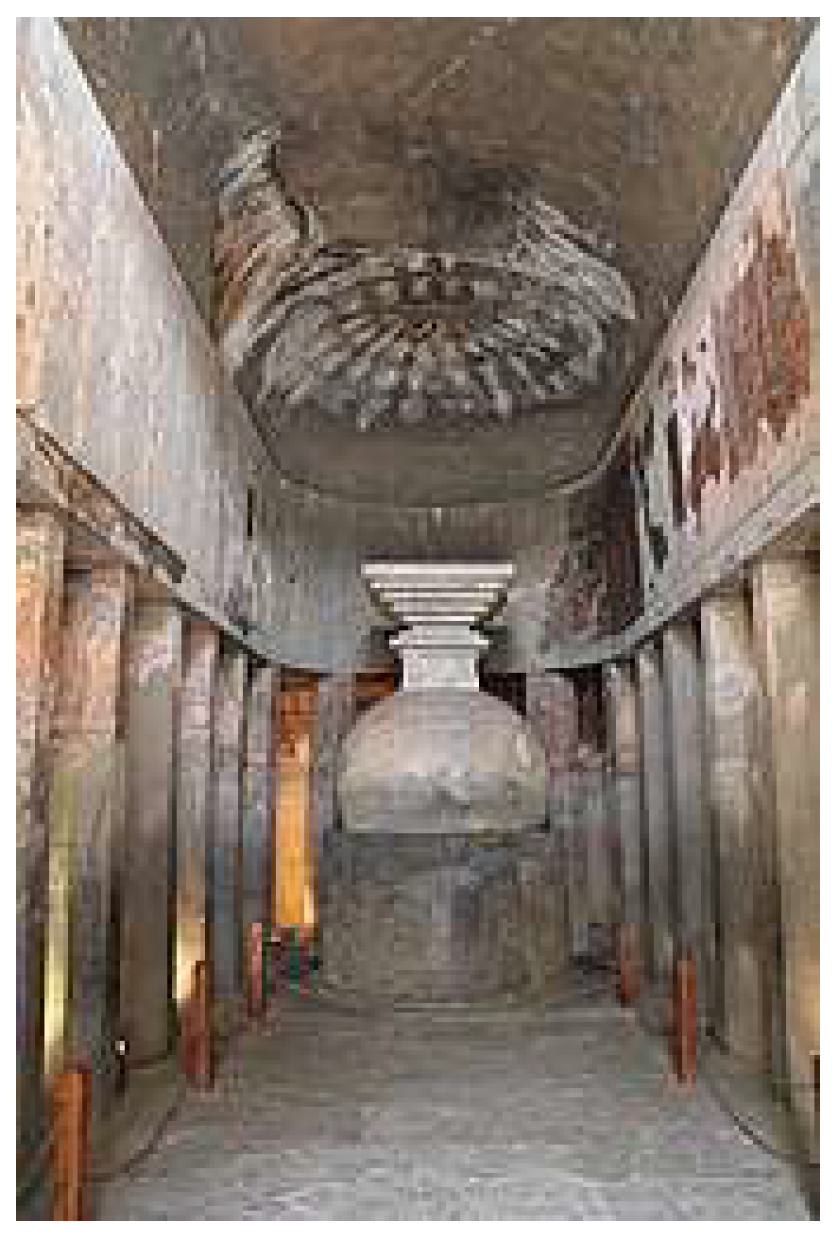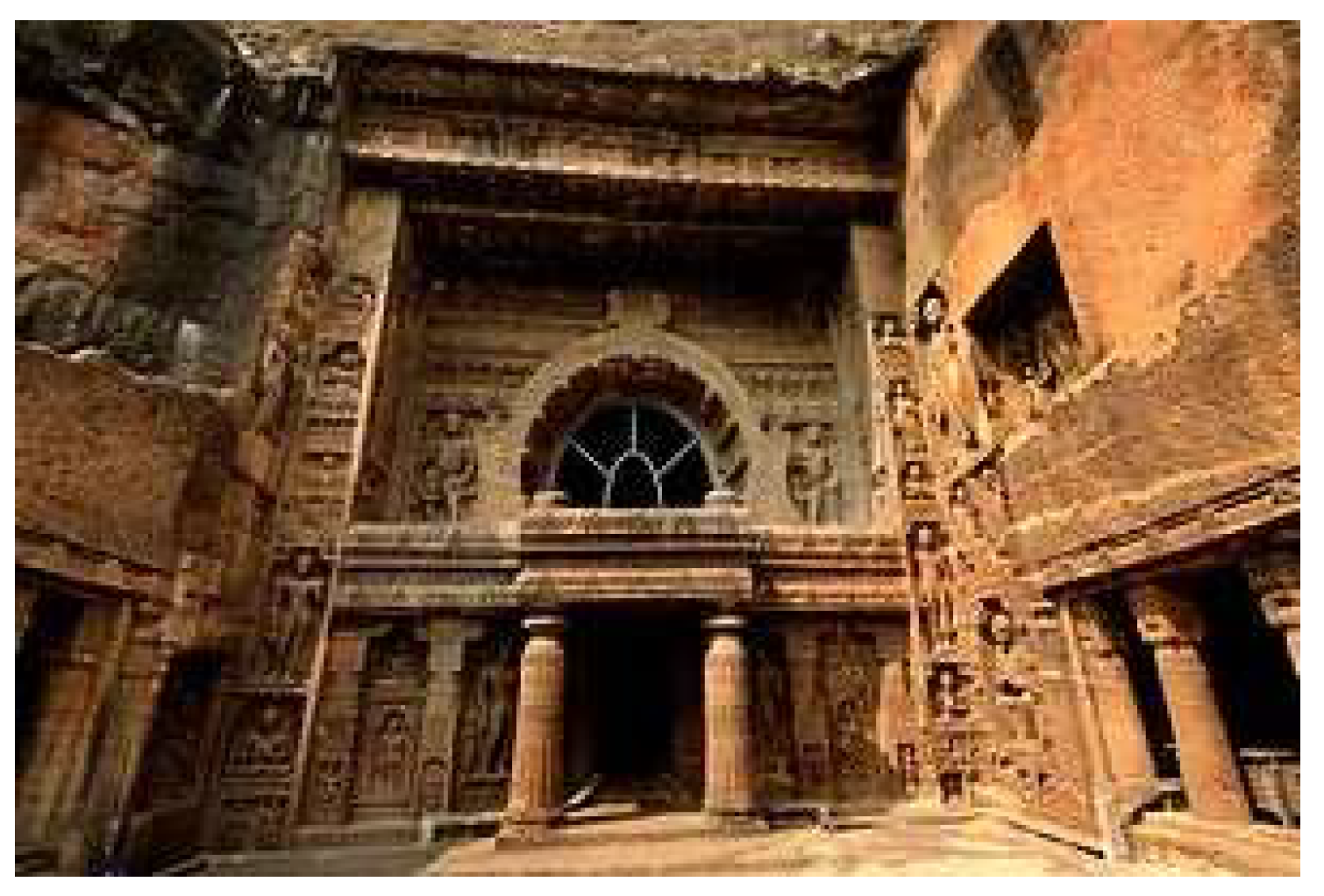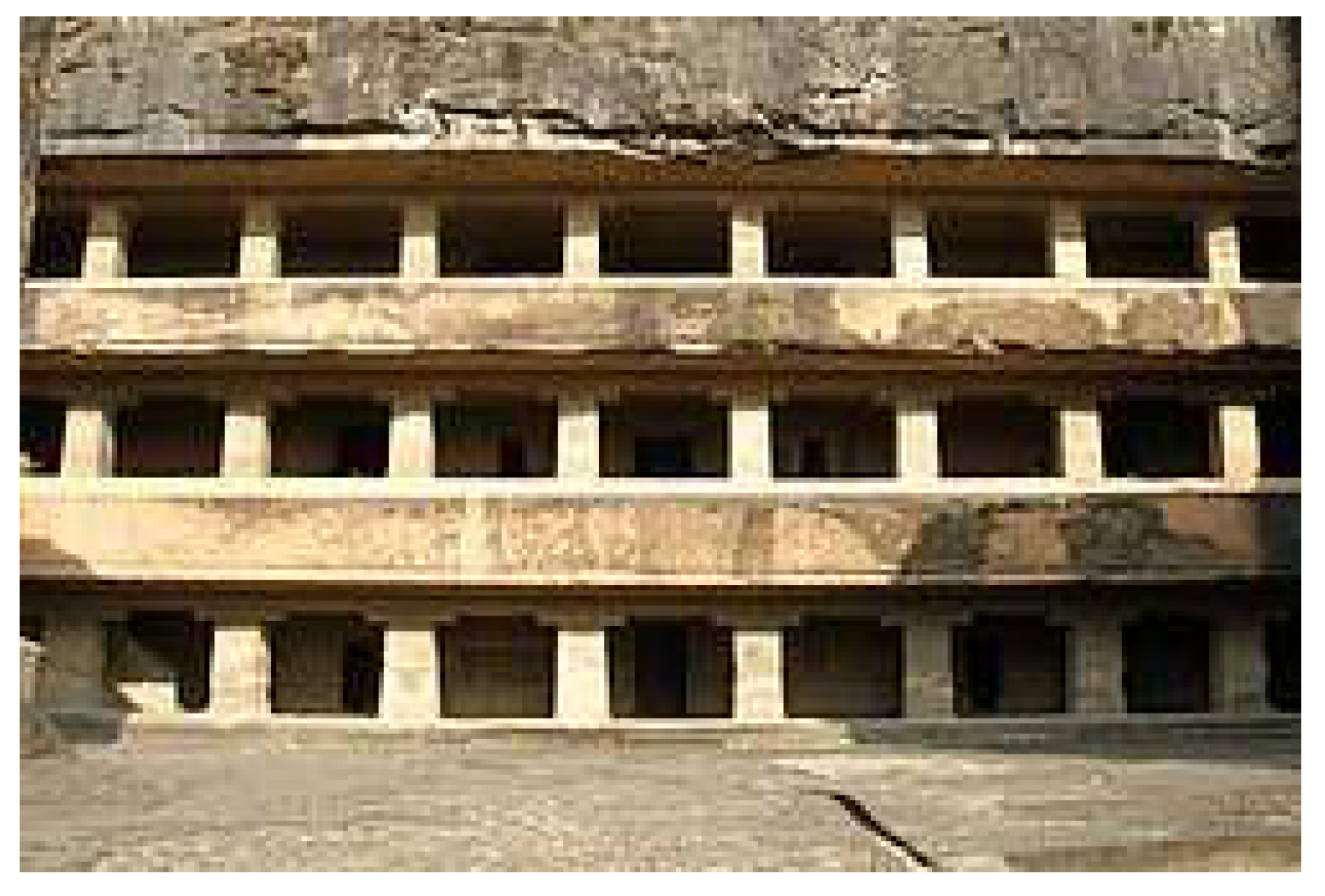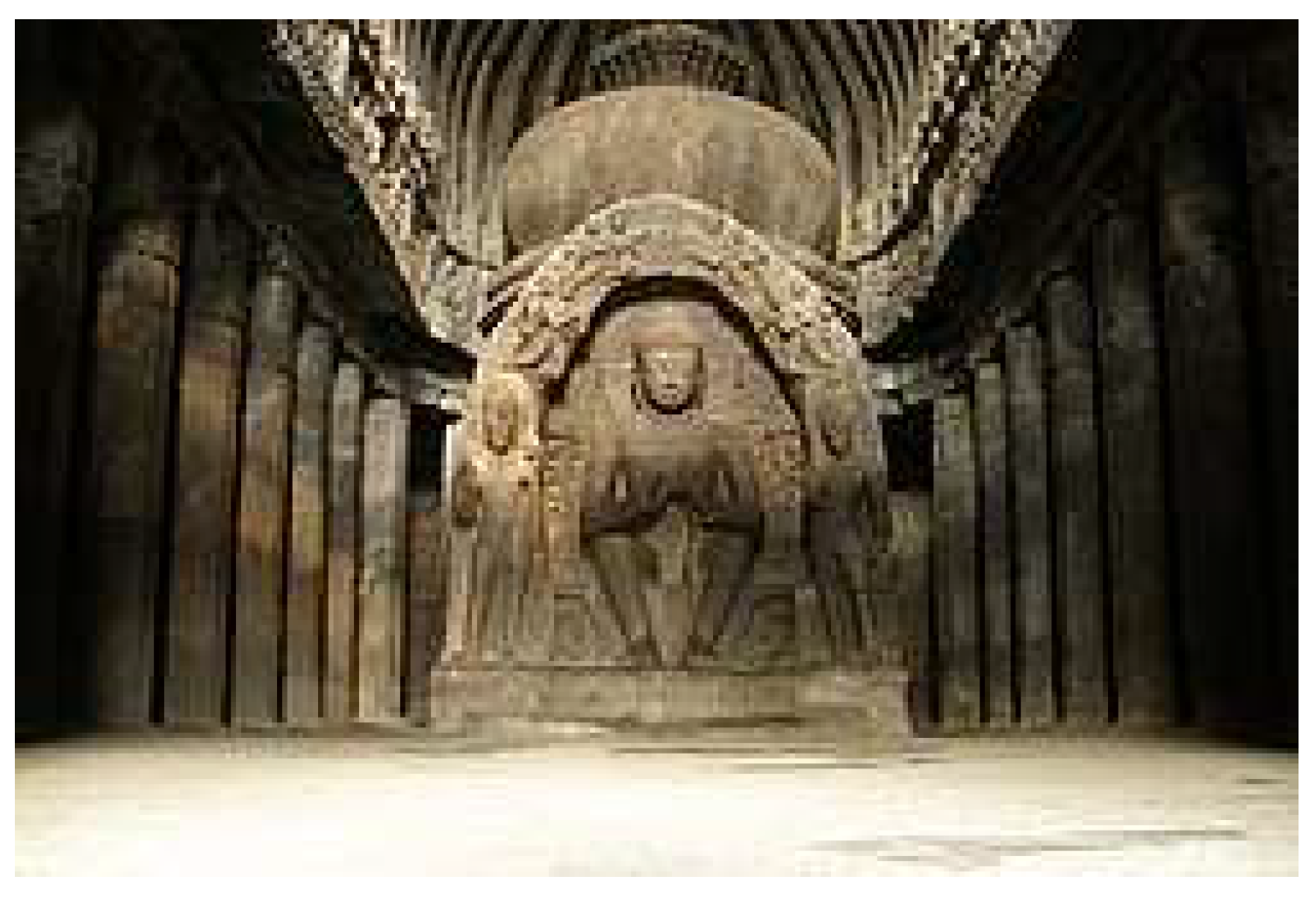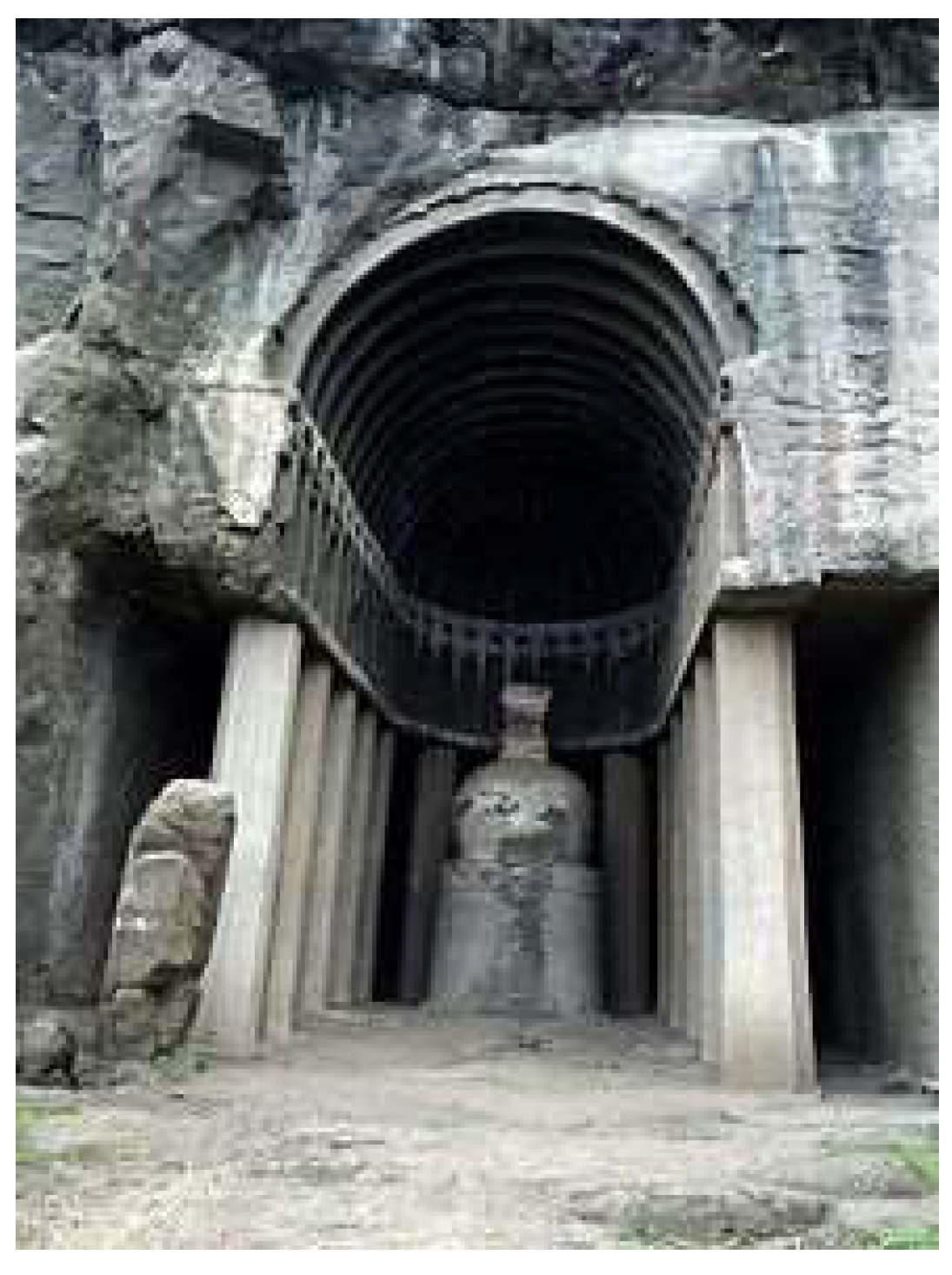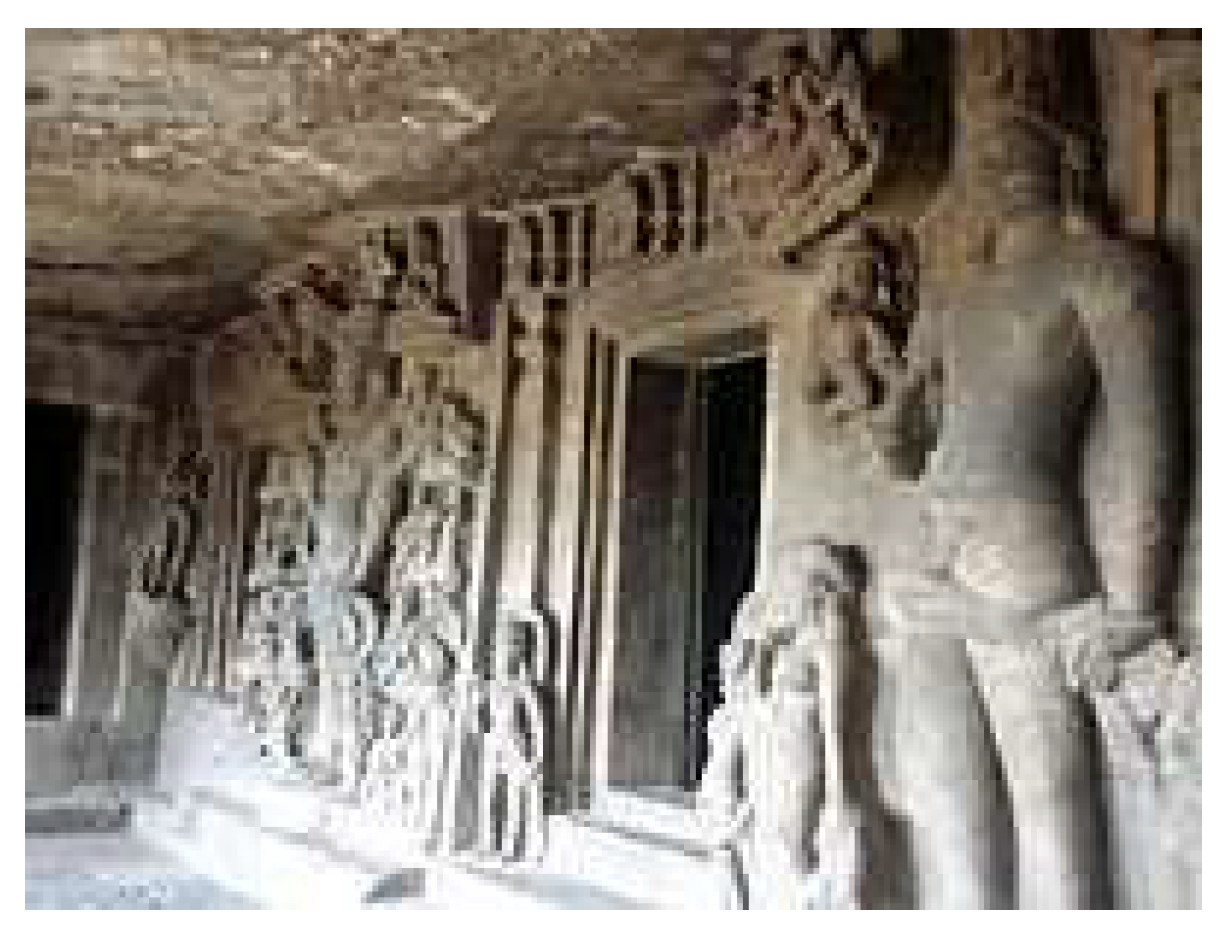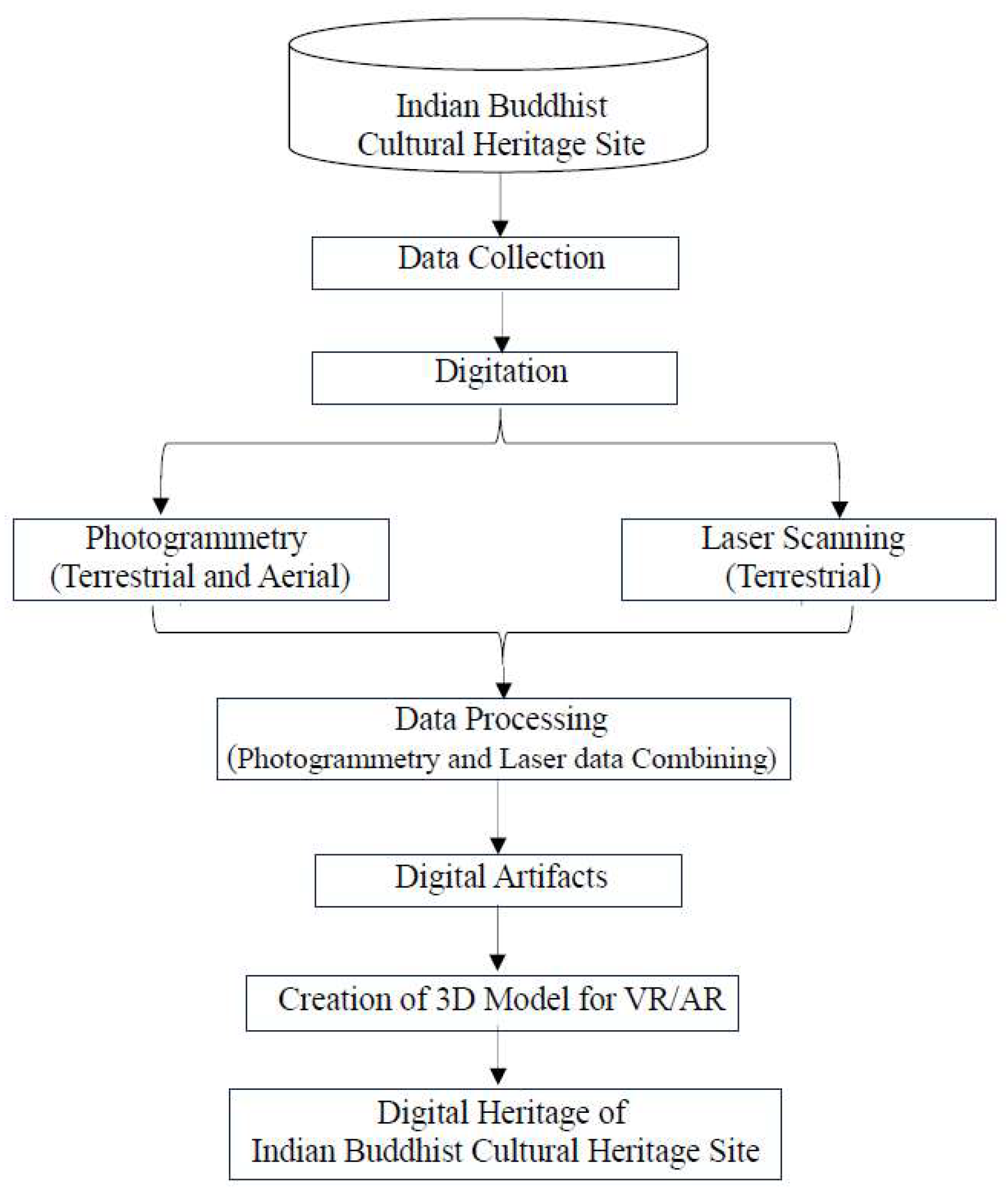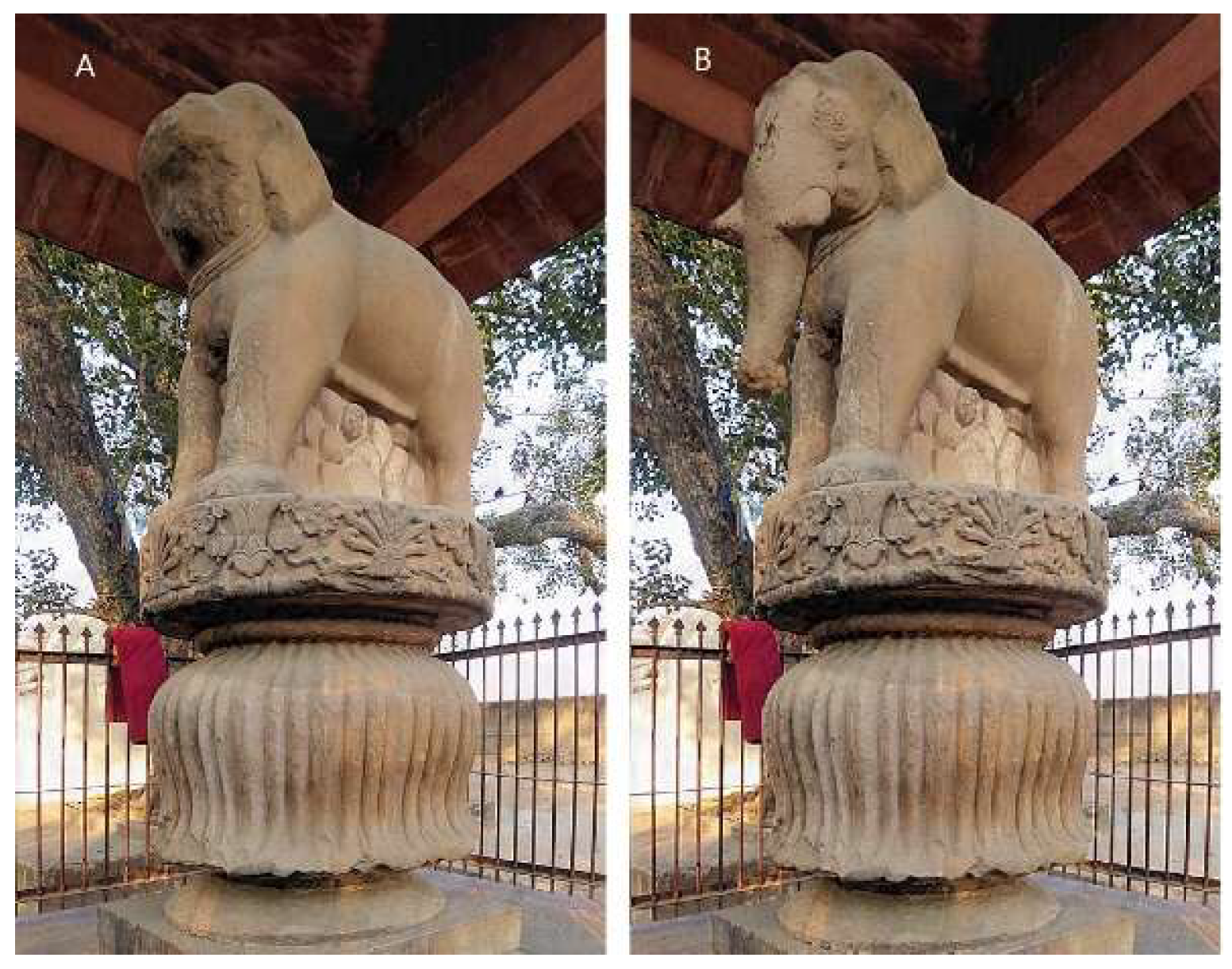II. Research Purpose
For our study we have selected 15 Buddhist cultural heritage sites like Bodhgaya (Mahabodhi Temple, Buddha Statue, Sujata Stupa), Sarnath (Chaukhandi Stupa, Dhamek Stupa, Dhamarajika Stupa, Mulgandhakuti Stupa), Kushinagar (Mahaparinirvana Temple, Mathakaur Shrine, Ramabhar Stupa), Rajgir (Vulture Peak, Pippala Caves, Sataparni Caves), Sharvasti (Jetvana, Angulimara Stupa), Vaishali (Kutagarshala, Ashoka Pillar, Relic Stupa), Nalanada (Mahavihara), Sanchi (Great Stupa, Stupa 2, Stupa 3), Odisa (Diamond Triangle), Sankissa (Ashokan Elephant Pillar), Nagarjunkonda (Maha Stupa), Amaravati (Great Stupa), Ajanta Caves, Ellora Caves and Aurangabad Caves. These are all tangible immovable cultural heritage sites of India consist of Historical Buildings, Monuments, Arachnological Sites. These selected heritage sites are more than 2000 years old. In this thousands of years many natural and man-made disasters was occurring and it has damage to these historical sites. Also, excessive tourism is one reason of damages to sites.
Preservation of heritage site is very important because it gives future generations a sense of identity and continuity in a rapidly changing world. Historical buildings essentially represent the past and culture of a nation. Digital heritage enables the long-term preservation, easy access, wide sharing, and dissemination of physical heritage to the public. The purpose of digital heritage to preserve heritage digitally and it provides availability of heritage site to the public and prevent it from further damages. To achieve this, virtual reality (VR) applications should be applied.
III. Indian Buddhist Cultural Heritage
Bodhgaya
Bodh Gaya is the most sacred place for Buddhists and who always make this their first stop, on their Buddhist pilgrimage of India. Here Siddhartha Gautama underwent forty-nine days of rigorous penance under the sacred Bodhi tree to attain enlightenment and perfection. He became a Buddha from a bodhisattva.
The Mahabodhi Temple was first built by Emperor Ashoka in the third century BC. and the present temple dates from the 5th or 6th century AD. It is one of the earliest brick Buddhist temples still standing in India. It is 170 feet tall and known for its wonderful architecture and exquisite technique. There are stone engraved balustrades, large towers, small inscriptions, intricate Buddha images. In the centre of the temple is a grand and magnificent gilded Buddha statue in Bhumisparsha Mudra, 8 meters high with right hand touching the ground. The statue should be at least 1700 years old. Buddhists believe that if they pray in front of this statue, their wishes will come true.
Figure 1.
Mahabodhi Temple (Source:Wikipedia).
Figure 1.
Mahabodhi Temple (Source:Wikipedia).
One of the most striking images of Bodhgaya is the magnificent 18.5 meter Buddha statue in the wonderfully peaceful Dhyani Mudra pose on a lotus in the courtyard. The total height of the building is 2 m, of which the Buddha part is 20 m, the lotus on which the Buddha sits is 1.5 m, and the base is 3.0 m. The maximum width of the building is almost 18 m.
Figure 2.
Great Buddha Satute (Source:Wikipedia).
Figure 2.
Great Buddha Satute (Source:Wikipedia).
There are some beautiful temples and monasteries built by other Buddhist nations. These buildings are unique as they reflect the architectural styles of their respective countries. Buddha statues in Chinese temples are 200 years old and were brought from China. Japanese temples in Japan are shaped like pagodas, but Myanmar temples are also similar to the famous Bagan temples. Thai temples have gold tiles and huge bronze Buddha statues.
Sujata Stupa, also known as Sujata Stupa, Sujata Kuti Stupa or Sujata Garh, is a Buddhist stupa located in Senanigrama Village (Bakrawl), just east of Bodh Gaya, Bihar, India. It is located just opposite the town of Bodh Gaya on the Palug River where Gautama Buddha is said to have attained enlightenment. It takes about 20 minutes to walk from Bodhgaya to Sujata Stupa. It was originally built in the 2nd century BC.
Figure 3.
Sujata Stupa (Source: Wikipedia).
Figure 3.
Sujata Stupa (Source: Wikipedia).
Sarnath
Sarnath is a very important Buddhist site as it was here that Buddha delivered his first sermon, called ‘Dharma Chakra Paravarthana’ or ‘Wheel of Dharma’, five weeks after his enlightenment. Here he disseminated the Four Noble Truths, the Eightfold Path and the Middle Path, the key principles of his Dharma. Here he established a sangha (council) with five of his former students.
It is here that the concept of the Triple Gem concept of Buddhism (Buddha, Dharma, Sangha) originates, as well as the famous mantra “Buddha Sharanam, Gachami”.
Deer Park, where Buddha delivered his first sermon, is Sarnath’s most enchanting site with its emerald green lawns, small hilltops, and the majestic ruins of many stupas and chaityas.
The Chaukhandi stupa on the hill is one of his one of the first tourist attractions to visit in Sarnath. It contains the remains of a Buddhist monastery from the 5th century AD and is said to mark the spot where the Buddha first met his five disciples when he arrived at Sarnath.
Figure 4.
Chaukhandi Stupa (Source: Wikipedia).
Figure 4.
Chaukhandi Stupa (Source: Wikipedia).
This sacred Buddhist city came to life when King Ashoka visited and erected the famous Ashoka Pillar. His four lion heads at the top of the pillar pointing in his four different directions, called Lion His Capital, are on display at the Sarnath Museum.
It is crowned by four life-size lions standing back-to-back on a drum-shaped primrose. The side of the abacus is decorated with relief wheels, between which follow from right to left four animals, a lion, an elephant, an ox and a galloping horse. The bell-shaped lotus forms the lowest part. it is the 2.1 meters tall, carved from a single piece of sandstone and highly polished, was attached to this monolithic pillar with a metal pin. It is emblem of India.
Figure 5.
Lion Capital of Ashoka (Source: Wikipedia).
Figure 5.
Lion Capital of Ashoka (Source: Wikipedia).
Ashoka also built the largest and most prominent stupa, the Damek Stupa. A large cylindrical tower 128 feet tall and 93 feet in diameter. The edges are delicately carved with geometric patterns, floral patterns, people and birds, and are very pleasing to the eye. The name Dhamek is related to Buddha’s “dharma”. Most Buddhists who visit Sarnath walk around and chant mantras around this stupa, which is said to be very auspicious.
Figure 6.
Dhamek Stupa (Source: Wikipedia).
Figure 6.
Dhamek Stupa (Source: Wikipedia).
There is also the Dharmarajika Stupa, which is one of the pre-Ashokan stupas in existence, which is believed to mark the very place where Buddha delivered his first sermon.
Figure 7.
Dharmarajika Stupa (Source : Wikipedia).
Figure 7.
Dharmarajika Stupa (Source : Wikipedia).
Other interesting sights in Sarnath include the Mulgandhakuti Vihara , where Buddha meditated during monsoons during his visit to Sarnath. The Sarnath Archaeological Museum is the oldest archaeological museum by the Archaeological Survey of India. Designed like a Buddhist Vihara Sangram, the central hall is like a shrine and the gallery is a monastery-like room. The image of a serene Buddha with half-closed eyes and smiling lips is unforgettable.
Figure 8.
Mulgandhakuti Vihara (Source : Wikipedia).
Figure 8.
Mulgandhakuti Vihara (Source : Wikipedia).
Like Bodhgaya, Sarnath city is dotted with monasteries from many Buddhist countries, including Thailand, China, Japan, Burma, Korea and Tibet. An important building is also the Central Institute of the Higher Institute of Buddhism.
Kushinagar
Kushinagar in Gorakhpur, Uttar Pradesh is where Buddha was buried in 86 BC after achieved Mahaparinirvana. His remains were collected in eight urns and distributed to various stupas throughout the country.
Figure 9.
Buddha’s body kept at this location for one week, after he attained Parinirvana (Source: Wikipedia).
Figure 9.
Buddha’s body kept at this location for one week, after he attained Parinirvana (Source: Wikipedia).
The Mahaparinirvana Temple is the most important monument here. It features a stunning statue of the reclining Buddha, 6 meters long.
Figure 10.
Mahaparinirvana Temple (Source: Wikipedia).
Figure 10.
Mahaparinirvana Temple (Source: Wikipedia).
Outside the Mahaparinirvana Temple of the Reclining Buddha is the small Mathakuar Shrine, with an interesting black stone statue of the Buddha in Bhumisparsha pose.
The Ramabhar Stupa is of great religious significance to Buddhists around the world as it is said to be the very place where Buddha was cremated and got Mahaparinirvana after his death in 483 BC. This stupa was built by the Malla kings who ruled Kushinagara during the Buddha was alive. In ancient Buddhist texts, this stupa was called Mukta Bandhan Chaitya or Mukta Bandhan Vihara.
Figure 11.
Ramabhar Stupa (Source: Wikipedia).
Figure 11.
Ramabhar Stupa (Source: Wikipedia).
According to legend, the word Ramabhar may have originated from a nearby pool or hill. The pagoda is made of brick and is 14..9 meters high. The stupa was built on a hill across from the Kushinagara-Deoria road. The pagoda’s round drums are 34.14 meters in diameter at the top and 47.24 meters at the bottom, and there is also a pond-like body of water nearby.
Figure 12.
Stupa ruins in Kushinagar (Source: Wikipedia).
Figure 12.
Stupa ruins in Kushinagar (Source: Wikipedia).
Like other Buddhist sites, Kushinagar also has beautiful monasteries from other Buddhist countries.
Rajgir
Rajgir was the ancient Rajagaha in the time of Buddha. It was the capital of the Magadha kingdom, whose king was the legendary Bimbisara, who was one of the most prominent followers of the Buddha. Buddha used this city as his monsoon retreat and preached his dharma.
At Rajgiri, the Buddha delivered his sermons from the striking Mount Gridhakuta hill or Vulture Peak (c. 563-483 BC), which had a unique rock formation like a vulture’s beak. Vulture, also known as Griddhakuta, is an important Buddhist pilgrimage site. It is one of the three best places where Shakyamuni Buddha or Gautama Buddha preached for many years. On a small hill, just outside Rajgiri, Griddhakuta is a popular tourist attraction at a height of 400 meters. This peak is known as Vulture Peak because of its vulture shape and offers frequent birding. It is said to be the place where Lord Buddha lived for many years.
Figure 13.
Vulture Peak (Source: Wikipedia).
Figure 13.
Vulture Peak (Source: Wikipedia).
Vulture Peak also offers a great 360-degree view of the entire environment. When King Bimbisara was imprisoned by his son Ajatashatru, he looked at the Buddha on the hill from his prison window and tried to find peace.”Bimbisrara Prison” was excavated in Rajgiri, as well as the fortress of Ajatashatru, where his son Ajatashatru repented after killing his father, converted to Buddhism and placed a Buddha image in the “Parinirvana” pose.
Also, there are the grand Pippala Caves and the seven Sataparni Caves, where the first Buddhist Council was said to have been held, after the Buddha’s Mahaparinirvana.
Shravasti
Shravasti was the capital of the ancient kingdom of Kosala and the largest city on the Gangetic plain at the time of the Buddha.
In Shravasti, the Buddha lived in Jetvarna Vihara in the lush gardens of Jetvarna. Today, it attracts many Buddhist pilgrims with its beauty and peace. The extreme calm here encourages travellers to rest, relax, pray and meditate. Buddha lived in Anandakuti and Gandhakuti. Its ruins still exist today and it is a holy place for Buddhist pilgrims.
Figure 14.
Gandhakuti. Buddha’s hut (Source: Wikipedia).
Figure 14.
Gandhakuti. Buddha’s hut (Source: Wikipedia).
The city is dotted with many ancient temples, monasteries, and pagodas. There is also the Angulimala stupa excavated in 1863. It was built in memory of the famous Dacoit killer Angulimala, who wore a necklace of human fingers around his neck. When he met Buddha, his kind words changed him and he became a devoted disciple.
Figure 15.
Angulimala Stupa (Source: Wikipedia).
Figure 15.
Angulimala Stupa (Source: Wikipedia).
Shravasti , also has many beautiful monasteries built by other Buddhist countries.
Vaishali
After Five years the Buddha’s enlightenment at Bodh Gaya, Buddha arrived in Vaisali, one of the first “republican” states in the world.
Kutagarshala represents the place where Buddha lived during the rainy season in Vaisali. Excavations have revealed three phases of its construction. Initially, it was a small Chaitya built during the Sunga-Kushana period (2nd century BC to 3rd century AD) followed by a second expansion into a large temple during the Gupta period. Finally, in the third phase, during the post-Gupta period, the temples were converted into monasteries providing number of partitions.
Figure 16.
Buddha Stupa, Relic Stupa, Ashoka Pillar (Source: Wikipedia).
Figure 16.
Buddha Stupa, Relic Stupa, Ashoka Pillar (Source: Wikipedia).
Great Ashoka erected his Ashoka pillar and a large brick temple here. One of the important places here is the Relic Stupa, where the Lichchavis encased one of the eight parts of the Buddha’s relic in 5th Century B.C.
Nalanda
The Nalanda Mahavihara covers an area of 23 hectares and dates to the 3rd century BC. This monastery is one of the oldest and largest in peninsular India at the time from 5th to 13th AD. before Nalanda was sacked and abandoned in the 13th century.
Figure 17.
The ruins of Nalanda Mahavihara.
Figure 17.
The ruins of Nalanda Mahavihara.
It includes stupas, shrines, chaityas, viharas, many votive structures and important stone and metal works of art. The historical development of the country witnesses the development of Buddhism as a religion and the flowering of monastic and educational traditions.
Figure 18.
Stucco Buddha image at Nalanda, Stupa of Sarriputta (Source: Wikipedia).
Figure 18.
Stucco Buddha image at Nalanda, Stupa of Sarriputta (Source: Wikipedia).
Sanchi
Sanchi, known for the earliest stone stupas with richly carved stone railings and toran gateways detailing the life of the Buddha, was discovered in ruins in 1818. There are many Stupas in this place, the most prominent of which is the Sanchi Stupa, also known as the Great Stupa. The Great Stupa was built by King Ashoka in the third century BC. UNESCO has listed them as one of the world’s cultural heritage sites. A stupa is a large hemispherical dome with a central chamber containing relics of the Buddha.
Figure 19.
The Great Stupa at Sanchi (Source : Wikipedia).
Figure 19.
The Great Stupa at Sanchi (Source : Wikipedia).
Stupa No. 2 was established later than the Great Stupa, but it is but probably has the oldest architectural ornaments. The themes of Buddhism, specifically the four events in the life of the Buddha: birth, enlightenment, first sermon and death, are presented clearly for the first time. The decoration of Stupa 2 is said to be “the oldest large-scale stupa decoration in history”, and this stupa is believed to be the birthplace of Jataka illustrations.
Figure 20.
Stupa Number 2 at Sanchi (Source: Wikipedia).
Figure 20.
Stupa Number 2 at Sanchi (Source: Wikipedia).
Stupa No. 3 was built during the time of the Shungas, who also built the railing and stairs around it. The relics of Sariputra and Maha Moggallana are preserved in Stupa No. 3. The single torana gateway in the south is not built by Shunga and was built later under Satavahana, probably about 50 BC.
Figure 21.
Stupa number 3 at Sanchi (Source: Wikipedia).
Figure 21.
Stupa number 3 at Sanchi (Source: Wikipedia).
Odisha
In the Bhubaneshwar, capital city of Odisha where Emperor Ashoka fought the famous Kalinga war, after which he converted to Buddhism in 262 BC. He issued the first Ashokan Edict on the site of the war. From Bhubaneswar it is a scenic spot in Dhauli, 8 km away, surrounded by beautiful Dhaulagiri hills, with the Daya river flowing in front of it. This is the oldest example of Indian petroglyphs, depicting an elephant emerging from a monolithic stone like a baby emerging from the womb.
Figure 22.
The Dhauli Major Rock Inscription of Ashoka. The front is shaped as an elephant. Dhauli (Source:Wikipedia).
Figure 22.
The Dhauli Major Rock Inscription of Ashoka. The front is shaped as an elephant. Dhauli (Source:Wikipedia).
There are Buddhist artefacts have been unearthed at three sites, Lalitgiri, Ratnagiri and Udaygiri, 100 kilometers from Bhubaneswar. They have been called Buddhist triangles or diamond triangles.
Figure 23.
Maha Stupa at Lalitgiri(Source: Wikipedia).
Figure 23.
Maha Stupa at Lalitgiri(Source: Wikipedia).
Figure 24.
Sculpture of the Buddha Fasting at Lalitgiri (Source: Wikipedia).
Figure 24.
Sculpture of the Buddha Fasting at Lalitgiri (Source: Wikipedia).
Figure 25.
Main Stupa at Udaygiri (Source: Wikipedia).
Figure 25.
Main Stupa at Udaygiri (Source: Wikipedia).
Figure 26.
Entrance to Monastery 1, Ratnagiri (Source: Wikipedia).
Figure 26.
Entrance to Monastery 1, Ratnagiri (Source: Wikipedia).
Sankissa
Sankissa was an ancient city in India. The city became famous during the time of Gautama Buddha. The shrine was erected on the spot where Buddha’s right foot first touched the ground at Sankissa.
Sankisa is mostly famous for its archaeological and historical importance. A Ashokan elephant pillar, Mega Tank and Buddhist sculptures from the Mahayana period have also been excavated on some walls of the site. There is an elephant here on top of the Asokan pillar. This elephant is said to represent the white elephant that Mayadevi dreamed time of conception of Siddhartha (Lord Buddha).
Figure 27.
Elephant Capital at Sankissa, one of the Pillar of Ashoka (Source: Wikipedia).
Figure 27.
Elephant Capital at Sankissa, one of the Pillar of Ashoka (Source: Wikipedia).
Nagarjunkonda
It is named after the famous Buddhist monk Nagarjuna who is famous Buddhist scholar and developer of Mahayana Buddhism. It looks like an island was once an important settlement in the 1st and 2nd centuries BC. It is an important centre of Buddhist learning, rich in flora and fauna, and an archaeological paradise. An extensive six-year excavation was carried out to reveal many Buddhist ruins, stupas, viharas (monastery complex), chaityas (temples) and mandapams (pillared pavilions), as well as some excellent examples of white marble from the life of the Buddha. Mahastupa is the most important stupa in Nagarjunakonda and is called the “Maha-Chaitya” in the Ayaka pillar carving because it probably contained the Buddha’s own ossuary.
Figure 28.
Ruins of the site Nagarjunkonda (Source: Wikipedia).
Figure 28.
Ruins of the site Nagarjunkonda (Source: Wikipedia).
Amaravati
The Amaravati Stupa, commonly known as the Great Stupa of Amaravati, is a Buddhist monument. The campus includes a Stupa and an archaeology museum. Construction of the Amaravati Stupa began around 200 BC. It has been renovated several times. One of the largest stupas built in Buddhist India, it was about 160 feet (50 m) in diameter and 90 to 100 feet (about 30 m) high, but was largely destroyed when local entrepreneurs used much of the stone to make lime mortar in the 19th century.
Figure 29.
Depiction of the Stupa, from the site Amaravati (Source: Wikipedia).
Figure 29.
Depiction of the Stupa, from the site Amaravati (Source: Wikipedia).
Ajanta Cave
Ajanta caves are universally regarded as masterpieces of Buddhist religious art. The art of Ajanta owes its inspiration to those early Buddhist bhikshus who came to western India in the wake of the spread of Buddhism under the patronage of Ashoka (273-36 B.C.). The Ajanta Caves are approximately 30 rock-cut Buddhist cave monuments. The caves are numbered not chronologically but as a matter of convenience, starting with the one at the outmost extremity.
Figure 30.
The Ajanta Caves (Source:Wikipedia).
Figure 30.
The Ajanta Caves (Source:Wikipedia).
The caves were built in two phases centuries apart. The first series of caves dates to the 2nd century BC. to the 1st century CE, while the second set of caves was built in the 5th century.
Caves no. 9, 10, 12, 13 and 15A were the first period-built caves. Caves no. 1-8, 11, 14-29 falls under the second period caves. Caves 9 and 10 are both stupa-based with a worship hall, and caves 12, 13 and 15A are vihara (where monks live).
Figure 31.
Cave 9, a first-period Hinayana-style chaitya worship hall with stupa but no idols (Source: Wikipedia).
Figure 31.
Cave 9, a first-period Hinayana-style chaitya worship hall with stupa but no idols (Source: Wikipedia).
Caves 19, 26 and 29 are chaitya Grihas (prayer halls) The other caves are viharas, or monks’ residences. There are amazing sculptures and paintings in the caves of the second period. Paintings and sculptures is a source of worship.
Figure 32.
Cave 19, Ajanta 5th-century chaitya hall (Source: Wikipedia).
Figure 32.
Cave 19, Ajanta 5th-century chaitya hall (Source: Wikipedia).
Ellora Caves
Ellora Caves is a multi-religious rock-cut cave complex with carvings dating back to the 6th century AD. and is in the Aurangabad district of Maharashtra, India. The site has more than 100 caves. All caves are excavated from the basalt rocks of the Charandri Hills, only 34 caves are open to the public. Out of the 34 caves, cave 1 to 12 are Buddhist caves developed between A.D. 450 to 650. These two groups consist of a single Chaityagriha (the prayer hall) and monasteries.
Cave 5 is the largest and most notable of Ellora’s first group of caves no 1-5. in the second group of Caves no 6-12, cave 12 is biggest and elaborate cave. it is also known as Teen Taal.
Figure 33.
Caves 11 (above) and 12 are three-storey monasteries cut out of a rock, with Vajrayana iconography inside. (Source: Wikipedia).
Figure 33.
Caves 11 (above) and 12 are three-storey monasteries cut out of a rock, with Vajrayana iconography inside. (Source: Wikipedia).
Cave 10 is most important cave. It is Chaityagriha. A huge seated Buddha is enshrined in the Dharmachakrapravarthan mudra carved in front of the stupa. this cave also known as Vishwakarma Cave or Sutara chi zopadi (carpenters hut).
Figure 34.
Part of the Carpenter’s cave- Cave no. 10 (Source: Wikipedia).
Figure 34.
Part of the Carpenter’s cave- Cave no. 10 (Source: Wikipedia).
Aurangabad Caves
Aurangabad Caves are rock-cut Buddhist caves carved out of soft basaltic rock built between 2nd and 7th century. It has ancient Buddhist architecture and includes Buddhist shrines and viharas. The site contains 12 caves that are named by number and divided into three groups. The first group includes caves 1 to 5 (the western group), and the second group includes caves 6 to 9 (the eastern group). The third group is made up of the three remaining caves, specifically Cave 10, Cave 11 and Cave 12 (North Group).
Cave 1 has a corridor decorated with large Buddha images supported by eight pillars. The main Buddha in Cave 2 is in the Pralambapadasana position, seated on a lion throne, while the hands depict the Dharmachakra Mudra. In Cave 3 Buddha statue seated on a double lotus in a preaching posture.
Cave 4 is a square chaitya (prayer hall) with octagonal pillars. It is designed with stepped mirror carvings, which can also be seen in the Ajanta Caves.
Figure 35.
Chaitya with stupa, Cave 4 (Source: Wikipedia).
Figure 35.
Chaitya with stupa, Cave 4 (Source: Wikipedia).
In Cave 5, the Buddha is seated in the padmasana Position with hands in dyana mudra (meditation). Cave 6 has Buddha sits on a Western-style lion throne, surrounded by other figures. There are two other smaller shrines in this cave that have Buddha statues. there are two Buddhist halls in Cave 7 and there are carved figures such as Tara, Pancika, Hariti, Ganesha and Avalokiteshvara.
Figure 36.
Various sculptures next to an entrance (Source: Wikipedia).
Figure 36.
Various sculptures next to an entrance (Source: Wikipedia).
Cave 8 is a small cave has two statues of Padmasana. The statues of Buddha, Padmapani, Manjushri and Tara can be seen in Caves 9 and 10. Caves 11 and 12 are simple halls, without carvings, with plain pillars.
Figure 37.
Meditating Buddha -Aurangabad Cave (Source: Wikipedia).
Figure 37.
Meditating Buddha -Aurangabad Cave (Source: Wikipedia).
IV. Digital Heritage
The Charter on the Preservation of Digital Heritage of UNESCO defines digital heritage as embracing “cultural, educational, scientific and administrative resources, as well as technical, legal, medical and other kinds of information created digitally, or converted into digital form from existing analogue resources”.
Accordingly, digital representation of heritage ensures that the essential value of its ontology is widespread and enduring. To achieve this, specified approaches are suggested for the use, research, and protection of two kinds of heritage, corresponding to its natural or cultural characteristics.
Figure 36 explains the stages of Virtual Reality technology - Digital Heritage Application process for preservation of Selected cultural heritage sites.
Figure 38.
Stages of Virtual Reality technology - Digital Heritage Application Process.
Figure 38.
Stages of Virtual Reality technology - Digital Heritage Application Process.
The proposed research is based on primary and secondary data. Primary data will be collected directly from selected Indian Buddhist Cultural Heritage Sites and secondary data is collected from books, websites After data collection, digitization will be done.
Laser scanning and photogrammetry are additional technologies that play an important role in advancing the digitization of cultural heritage. The digitization is performed using photogrammetry and laser scanning technology.
To better preserve heritage sites, we can use laser scanning and photogrammetry to convert cultural heritage sites into a digital format and store them in a secure database for future research and possible virtual exhibitions.
The complex process of extracting information from images to create accurate 3D maps and models. This practice uses high-resolution aerial photography to combine drone-mounted atmospheric sensors with powerful GIS mapping systems to create dynamic and measurable records for a variety of real-world situations and applications.
Automatic and live 3D raster measurement accurately measures and collects data on objects, surfaces, buildings, and landscapes. Laser scanners collect information in the form of point cloud data. it consists of millions of 3D coordinates (XYZ coordinates).
Both Virtual Reality (VR) and Augmented Reality (AR) are recognized for their rich experiences, bridging the virtual and real worlds through enhanced 3D visualization.
In the data processing phase, a combination of photogrammetry and laser data is performed. Once the point clouds are obtained. They are imported into common rendering software to assemble them into a unique 3D model for VR/AR. Full or partial reconstruction based on a scanned point cloud in case of weather or natural damage disasters, fires, etc. An assessment is being made for possible reconstruction of the damaged site.
Figure 39.
A) Damaged Elephant capital at Sankissa , (B) Possible reconstruction of Elephant (Source: Wikipedia).
Figure 39.
A) Damaged Elephant capital at Sankissa , (B) Possible reconstruction of Elephant (Source: Wikipedia).
The 3D models were created by adjusting shape, terrain, surface, light and complex design using transformable polygons. The 3D models were then compared to the captured digital images to achieve lifelike resemblance. Finally, textures were added to achieve photorealism in the final rendering of the 3D models.
Figure 40.
D Model of Ajanta Cave 1 – Exterior.
Figure 40.
D Model of Ajanta Cave 1 – Exterior.
Once VR/AR 3D Model is generated it will virtual heritage for site will be available for tourist.
